Skrewdriver
History
Was a Rock Against Communism band from the north-west of England, United Kingdom.
The history of the band starts with Ian Stuart Donaldson and the band Tumbling Dice.
1957
lan’s father Arthur Donaldson grew up in the northern industrial town of Wigan and became a engineer by trade, later owning a family tool making business. He was married to Irene who came from Hyde in Greater Manchester. They married in 1953 and the couple set up home in a three bedroom semi-detached house in Hawthorne Grove, Poulton-Le-Fylde near to Blackpool, Lancashire. Ian Stuart Donaldson was born at the Victoria Hospital in Blackpool on 11th August 1957.
In the house but next to the Donaldson family was the Grinton family. Their son, John, was an Ian’s first childhood friend at age two. The twosome continued to be best-friends in later life.
He was not an only child and at the age of 5 Ian gained a brother named Anthony even though as they grew up they drifted apart and went on their separate ways. Ian loved to tease his younger brother as brothers all over the world do. His parents would regularly come home to find he had locked Tony in the coal shed, or was frightening him with ghost stories.
Ian grew as a typical child and was always out and about in some adventure or another. From tree climbing, pranks and other cheeky scrapes. But Ian’s number one past-time was football. He was quite the young athlete, supporting Manchester United.
After joining the local Baines Grammar School, Poulton in 1968 he was immediately chosen to play for the school football team. With the nickname Don, Ian spent many hours training and for his age was a talented player. He was even approached by several club scouts to be signed up, but for Ian he became bored once he knew he was the best he could be and looked elsewhere for a new challenge. Not only on the sports field did Ian show his skill, he also showed a great intelligence in the academic classroom also. Leaving Baines Grammar School with 5 high-grade O’ Levels. Always proud and fearless, Ian grew a reputation for not being a push-over. During a Cub Scout trip to Switzerland he managed to get into a fight with an American boy. Ian enjoyed fighting and became good at hitting hard and dodging the blows.
By 1969 skinheads hit the streets and the newspaper headlines and Ian already knew his parents would never allow him to adopt the skinhead style and clothes wear.
With the first skinheads emerging in the summer of 1969 at a free Rolling Stones concert in Hyde Park London a new cult was in it’s infancy. The following year Richard Allen wrote a novel telling the tale of a young Skinhead named Joe Hawkins. The book became a youth-bible and sold in it’s thousands and promoted the cult even further. With the skinhead cult gaining full momentum hitting all the major towns and city streets and newspaper headlines too, whilst Ian himself was gaining a name for himself for being a bit of a handful, he knew his parents would never approve of him wearing boots, braces and shaven head. Once a rebel, always a rebel, Ian rescued a pair of old steel capped boots from the school bonfire. With his grandfather help of some spare cash he got his hair cropped for the first time. Waiting for the weekend, Ian and his mates, the McKay brothers who lived over the road from him, John Grinton, and the school gang would jump on a bus and take a trip down to Blackpool promenade, sea front. The mob would swagger along the “golden mile” bumping into the tourists, hanging around the Blackpool Tower and stomp along the arcades in their boots and Harrington jackets. From eating chips, to having a drink and usually finding bovver was their life.
After a few years with skinheads moving out of fashion Ian grew out his crop and became what was known as a Suedehead amongst the ex-skinheads. With Glam-rock now becoming the latest fashion trend Ian and his chums preferred the harder rock of the Rolling Stones and The Who.
1975
Ian and his mates had been messing around with musical instruments for a while now. With Ian’s mate Sean McKay learning the guitar and Grinny was getting into the drums, Ian himself had learnt a few chords on an acoustic at home and Phil Walmesly, an old school mate of the lads from Baines School, liked the bass and wasn’t too bad a singer. The talk of forming a band soon came a reality. Doing a few cover versions together at home, it was a band re-shuffle in 1975 with Phil on lead guitar, Sean on bass, Ian on vocals and Sean’s brother Kev came in on bass. By December the lads officially formed a band and named themselves Tumbling Dice, after the Rolling Stones song by the same name written in 1972 taken from the album Exile On Main Street.
1976
New Year’s Day 1976 was the date for their first gig as Tumbling Dice in the Newton Hall Holiday Camp. Playing for half an hour the band belted out cover versions by the Stones, Free and The Who. It was a decent first gig, with the only complaint being that they played too loud! Two weeks later, Thursday the 15th, the band were pencilled in to play a private disco at Cleveley’s Philharmonic Society. The band did two half-hour sets which earned their first wage of £3. They were well received although still inexperienced. During the second half of the set the Police were called in because of complaints the band was too loud! Next was Saturday 31st at the Hambleton Disco. Although hampered by a small stage and a bad P.A. the covers of Riot In Cell Block N° 9 and All Right Now went down very well earning them a whole £10. On 5th February, the band entered a talent competition at the Brunswick Club, Blackpool. Three bands entered and Tumbling Dice came second, Ian thought they were the best of a bad lot, and quite a lot of people thought Tumbling Dice should of won.
Back to the Hambleton Disco on 28th February with its tiny stage again and a pathetic crowd. It was Phil’s first night with a new guitar and some geezer complained that the band were far too loud so Ian ended up giving him a slap! Next was gig was 3rd March, a Under 18’s Teanlowe Disco, Poulton. The band did two half-hour sets, played well and went down well. Two weeks later and Tumbling Dice played the place once again and once again earning no cash. Back at the Teanlowe Disco again for a Baines Grammar School 6th Form Association. Tumbling Dice did an average first set despite a bad P.A. and in the second they had the place going wild to Black Sabbath’s Paranoid. Grinny put on a commendable performance and put his snare skin through by kicking his drums over as the finale all for payment of £8.
On the first Saturday of April 1976, the lads had a bit of a fall out with Grinny over something and nothing. A mate of the band Steve Gaiter stepped in on drums and the band were back gigging on 14th April, with Tumbling Dice trying their luck at another talent competition this time at the Welcome Inn. Out of seven acts Tumbling Dice came sixth. Steve played well for his first gig, but Ian thought the whole thing was a big hassle. The organizers didn’t give the band any time to tune up, as a result all the guitars were out of tune and they sounded awful! A week later for a gig at Papa Jenks, also on the bill were Eager Beaver and Jenks Revolution. The lads went down fairly well, but there was only a small turn out, and someone in the audience complained (believe it or not) that the band wasn’t loud enough! Payment received £7.50. The Landlord of the Dixon Bar was at the gig he liked what he saw and arranged a booking.14th May, the band traveled over to The Mill House Rock Club, Blackburn, Ian had a few pints before the gig and ended up dancing about on stage. Someone from the crowd played along with a harmonica and the band pulled off one of their best gigs yet earning £20. Next was the following Sunday at the Carters Arms Social Club, Preston. The first set wasn’t loud enough, but were tight. The second set they played a lot louder and better, and went down well earning some £18.
The Landlord of the Dixon Bar kept his word and Tumbling Dice played his venue on 21st May.. The band didn’t exactly play stupendously, but to give them their due the place was full of old timers and Rolling Stones’ covers weren’t really to their taste, the Landlord promised more bookings though earnings were £20. Just over a week later the lads were gigging at Grange Park Community Centre in Blackpool. The band were expecting a good turn out as the venue had forked out a few quid on advertising. Sadly, someone told the Gazette the wrong date. Friday instead of Saturday, so only a small crowd turned up. On the up side some bloke was really impressed with the band and wanted to manage them, plus to show he wasn’t bullshitting he threw £100 in the pot and the band earned £25.
Wednesday 2nd June the band took a trip up the M6 to The Red Well Pub in Carnforth. They played quite well and pleased the audience who were dancing and clapping, Ian was a bit pissed off with the microphone as he kept getting electric shocks! Payment received £20.
Three days later the lads were back on the road, this back at the Carters Arms Social Club. The band did three spots and came across very professional with everyone playing well. Chris from Eager Beaver joined the lads on stage in Johnny B. Goode and they earned £20. Next up was the Knott End Social Club, Friday 11th June. A small crowd but filled up as the lads played. The band played excellently, with everybody singing and dancing, Ian must have got a bit to carried away as he ended up falling off the stage for £20 earned.
Sunday 20th June, the boys travelled over to Burnley to play The Crossed Keys. They went down averagely, not too big a crowd, Ian complained to the band that they needed a bigger P.A. amp. Next month it was off to the Louise Anna Bell Disco Grand Hotel, St Annes. The P.A. amp blew twice, and the lads caused a bit of a riot afterwards with it kickin’ off with a gang of Soul boys all for just £15. Three days on the band was back playing Grange Park Community Centre. The crowd danced and applauded and the band went down well. A week later the band did a two day mini tour of White-avens in the Lake District. The lads thought they’d make it a bit of a do, and brought a few of their mates along. The first night they played Lowca Social Club, they played well, and everybody was up dancing through both sets. The group got 3 encores which earned the band £35. The second night the band gigged at the Whitehaven Social Club, the lads played very well again. People turned up from the previous night and were up dancing and standing on tables. The band got 3 encores again and everyone had a great night apart from the manager of the venue who said he wasn’t going to pay the lads because the bands followers had disrupted his club. The group had a word in his ear and managed to persuade him otherwise to receive £40.
A demo tape had been made a few weeks before and was sent out to recording labels. When the band returned home they had received a reply. A record label in London was waiting for them offering them a deal. The future looked promising but after discussing the news with fellow band members, some had doubts. Ian was all for it thinking this was the break they’d been waiting for. In less than a year the band had gone from being a group of amateur musicians getting paid £0 to a tight little band who had built up a loyal following and could demand £40 a gig, plus now they had a London record company who wanted to sign them up. But the rest of the band weren’t so sure and to seal an end to the deal Sean McKay refused to move and travel down to London. So by the summer of 1976 the band was finished.
When Tumbling Dice finished Ian formed a new group with Grinny, Kev and Phil. Ian had played a little rhythm guitar in Tumbling Dice, but he wanted to write his own material and saw being an accomplished guitar player as the first step. Before most of the bands’ songs had been written by Sean McKay. Ian took most of his musical inspiration from bands like The Who, The Rolling Stones, Free, Lynyrd Skynyrd and Led Zeppelin.
In the Sixties, when times were good, young people were looking for something heavy to get into and progressive rock carried messages of protest and revolution. By the mid-Seventies, times were so bad that people were looking for something different. There was a decline in music which attempted to carry any kind of message. Radical statements were out. In 1975 Britain’s biggest group was Queen, who had nothing to do with Rock and Roll. They were bunch of University music graduates. Their albums took thousands of hours, and the lighting scripts for stage shows were as complicated as the lighting scripts for a stage play. Freddie Mercury was about as controversial as a dead budgie. For young people like Ian there was nothing original coming along. Overall, rock music was stagnating. The music industry was just ripe for a wake-up call, and what better way than a kick in the bollocks. Sid Vicious was standing at the ready to take his turn at capturing the rebellious spirit of the youth.
The kids were bored to death, it was time for a change – and the youth of the time had no intention of waiting for the politicians to tell them what they already knew. History had taught them something – the establishment is hard to budge, but it is not immovable if the force of numbers are behind it. The year was now 1976 and this era brought with it the birth of a new sound, Punk and it was born yelling and screaming.
A few weeks later Ian and his new band travelled down to Manchester’s Lesser Free Trade Hall to see the Sex Pistols play supported by the Buzzcocks and Slaughter and the Dogs. With Johnny Rotten and his spiky red hair and green teeth shouting “Fuckin’ Anarchy” to several hundred sweating, pogoing youths was something very new. Punk, it was something new, fresh, full of aggression and raw rebellion. The boys returned home and Ian started to write a few Punk tracks. Ian was busy learning guitar and the band where still doing a few pub gigs. When they thought they’d got their sound about right, they decided to do a demo tape and send it off. A couple of places replied saying they were interested, but they wanted to hear a more professional recording, probably because the tape they sent was recorded in a metal factory.
Chiswick Records replied and a rep came up to see the band in Blackpool. After seeing and meeting them he offered the band a recording contract. Chiswick Records asked the band to come down to London and do a session in the studio. Ted Carroll, the former manager of Thin Lizzy, was the chairman of Chiswick Records and he signed the lads up. The band now required a name, Chiswick provided a name list and Ian chose Skrewdriver.
1977
The new lineup performed for the first time in February of 1977, alongside the main act of Lil Bob Storey from France at the Manchester Polytechnic College. The band – lan, Grinny, Kev and Phil – moved to London to be near their record label and set about promoting their name by playing regular gigs. It was at one of these gigs a London Weekend Television researcher spotted Skrewdriver playing, and a couple of days later the lads were interviewed in a café by Janet Street Porter, the program was called Year of Punk. The plan was now to record a first single in London. Entitled You’re So Dumb it was a hit at the use of drugs which was even then very prevalent throughout the music scene. Although it didn’t go down to well with certain people. But it did gain the band support among the working class council estate punks who saw drug taking as something the middle-class posh kids did trying to be rebellious. This single established Skrewdriver’s credentials as a punk band, and Chiswick updated the record deal to two singles and an LP.
With the local press taking notice and some three weeks after the singles release Chiswick Records boss Ted Carroll told Melody Maker of this delight with the 7″ and his belief in the band. “Skrewdriver is a band we like. They have had no press coverage and it is not yet available in the bigger stores but more than four thousand copies have already been sold.”
Skrewdriver did their first London gig at Andrew Czezowski’s club The Roxy, Neal Street, WC2 on 16th April 1977. The band were warmly received and reviewed throughout the Punk fanzines. The band played on the same bill as 999 and Boomtown Rats at the Music Machine in Camden on June 30th 1977. The crowd of all sorted punks didn’t appreciate the Boomtown Rats more refined new-wave pop. Bob Geldof was strutting around the stage impersonating Mick Jagger. This really annoyed Ian who at the time was talking with ‘Big Vince’, a hardcore Punk with a violent reputation. Ian told Vince to “dock that wanker Geldof”. The audience had already started throwing bottles, but when Vince began to walk up the stairs to the stage, Bob Geldof thought he was coming up to join him singing. “Whack!” The next thing he knew, Geldof was knocked to the floor sparked out cold. With more and more gigs, more and more skinheads came and a new wave of the original cult came back. One gig regular was 16 year old Graham McPherson better known as ‘Suggs’. Ian would often go out drinking with his ‘North London Skinhead Elite’, which consisted of Suggs, Chas Smash, Toakes, Chalky and most of the faces that appeared on the first Madness LP. Ian decided to give Suggs a job as an unpaid roadie in return for free gig entry.
In an interview Ian did for Melody Maker in 1977 he was asked if Skrewdriver were a non-violent band, shocking the reporter Ian replied “No, No, I actually enjoy fighting. Fighting was the only thing to do in Blackpool. There were no rock concerts; you had to travel to Manchester or Liverpool for that. Blackpool is for pensioners.”
Next release was a double A side single of Anti-Social/19th Nervous Breakdown in October 1977. 19th (Nervous) Breakdown was a Rolling Stone cover track.
Following that by a few weeks in November 1977 was the LP All Skrewed Up selling for £2.50 which contained 12 all original tracks and one The Who cover. The media reviews were quite reasonable. Sounds did a good write up of All Skrewed Up LP and the New Musical Express also gave a decent review. Even Melody Maker and Record Mirror said it was worth a listen. Things were looking good and Skrewdriver’s future looked bright, even one of the bands roadies Graham McPherson thought he’d try for his 5 minutes of fame and started singing with a local band – The North London Invaders.
The demand for All Skrewed Up and Anti-Social outstripped the more than popular debut single You’re So Dumb. Soon after the single and the LP were recorded, guitarist Phil Walmsley decided to quit Skrewdriver and was soon replaced by an old mate of the band also from Fylde, axeman Ron Hartley.
It was around this time the band was asked to attend the BBC studios in Madia Vale to put down a few tracks for the radio show called the John Peel Sessions. Skrewdriver recorded four tracks – Anti-Social, The Loner (a song about football violence), Streetfight, and Non-Believer (an anti-religion song). The band were duly impressed by the engineering and sound quality of the BBC production tracks.
Soon after Ron joined the group the band decided to scrap their punk image in favour of the smart but hard skinhead style. Soon Grinny cropped his hair first and the others followed his lead. All the band were fed up with the poseurs who were turning up and claiming they were Punks. The whole Punk thing had become plastic-fake and was losing its raw street appeal. Punk was turning more trendy left-wing, it had become mainstream and fashionable and full of poseurs. Most of the band’s friends who went to the gigs were skinheads and all the band had been skinheads a few years before anyways. With plenty regular gigs in and around London the band was attracting a good sized following. Playing as the support for Siouxie and the Banshees, 999 and The Boomtown Rats. The lads would often have drinks with Jimmy Pursey of Sham 69 fame and on one occasion when they played with the Police, they got pissed up at the bar with Sting and ended up lending their PA equipment to them to use. Now that Skrewdriver were officially a skinhead band, an increasing amount of skins started to follow the band. There was something of a skinhead revival in the late 1970’s and the National Front made the most of this by forming the Young NF in 1977.
The band acquired a reputation for violence, and when a near riot kicked off at the Vortex, at which Skrewdriver was playing, the music media made the most of it by slagging off the group’s audience as “thugs” and “National Front supporters”. With more media stories that many skinheads were involved with either the National Front or the British Movement, the Marxist dominated music media began to demand that Skrewdriver and the other leading skinhead band Sham 69 denounce their audience as racists. Skrewdriver refused to condemn their loyal followers, many of whom were friends, and as a result got banned. Banned from playing, banned from advertising, banned from press coverage, banned from radio play, and banned from gig promotion! However Sham 69 fearing no gigs and no money complied willingly to the demands of the press, and Sham’s front man and one time Wimpey Bar worker from Surrey Jimmy Pursey danced happily to the music media’s tune.
Unfortunately the bands promised third single Streetfight 7” never made it past the planning stages. Because of Skrewdrivers increasing violent reputation or through Chiswick’s growing disheartening with them, the record label told the band and especially Ian to condemn the right-wing skinhead element that had latched on to the band. This kind of reputation could finish the band they were told. Ian himself was a skinhead and most of the skinheads he was hanging around with were racist and he wasn’t going to condemn them. Although he was in no way connected to any political parties at this stage, he was probably as racist as many of them and often referred to black people as ‘coons’.
1978
Early in 1978 Ian was at the Fairport Convention concert and got involved in a fight with bouncers and received a beating, requiring some thirty-two stitches in a back wound. The band soon after made their first European gig in Paris headlining at the Gibbs Club in Paris. With Chiswick still telling Ian that they would get nowhere as a skinhead band and the music journalists wanting Ian to make a statement distancing the band from their skinhead following, by late 1978, Chiswick Records asked the lads to change their image and sent them to a farm in Peterborough to prepare for a new LP. On their return the band had a big row with the management and told Ted Carroll to fuck off. The management at Chiswick didn’t like the way Skrewdriver wouldn’t bow down to the media and denounce the racist skinheads supporters the band were attracting. Faced with nowhere to play, and unable to get a new recording contract, the pressure took its toll and Skrewdriver split.
1979
It was now 1979 and Ian and some of the band were based up in Manchester. Chiswick Records sent up Roger Armstrong to see the band before a deal to record a second album. He was disappointed that the band’s new material was not “punk enough” and the band had left behind its punk image. This was the final chance between Chiswick Records and Skrewdriver.
Ian was so angry at the way the Marxist left-wing liberal controlled the music scene in London that he began to take an active interest in nationalist politics. Ian wanted to find out for himself what it was that the music industry were so frightened about and why they were so terrified of National Front and its involvement in music.
Ian enjoyed being a skinhead and could see nothing wrong with being patriotic. One of Ian’s friends was a fellow Lancashire skinhead known as ‘Scully of the Eastend’ because of his dodgy Cockney accent. Ian didn’t like blacks and his experience of them during his time in London had done nothing to alter his feelings. Almost all the skinheads he knew were racist. Ian joined and soon became an active member of the emerging Young National Front section. With no future for the moment in Skrewdriver Ian decided reluctantly to return to Blackpool.
1997 the Sun newspaper ran a small article under the heading “DJ Drum Secret” in which it revealed Radio One Breakfast DJ Mark Radcliffe once drummed for Skrewdriver. Mark did fill in for Grinny on the odd occasion when John was back home visiting his family. Drummers are hard to come by, not exactly Stop Press classified information. Back in the Fylde, Ian started work as a clerical assistant at the nearby Premium Bonds office. He still was a skinhead and was soon back to the odd fight or two. Poulton and Blackpool had a history of rival gangs from the opposing towns. These would regularly come into contact at the weekend. Once a gang of Poulton lads who Ian was with went on the rampage down Blackpool. People were attacked, windows smashed. The following week The Ramsden Arms Pub on Tabolt Road, had a photo of Ian behind the bar with the words Wanted Dead Or Alive written above it. lan’s reputation from school had never gone away. On another occasion some NF supporters (Tweety and the Cannon brothers) who Ian was friendly with asked if he’d like to go and see The Stray Cats who were playing at the Norbreck Castle, in Bispham. The Stray Cats were quite big at the time and in the charts, Ian tagged along and at the gig the lads did everything they could to annoy the band. Ian thought they looked like a bunch of puffs. The result was a confrontation in the pub car park with the band and their roadies after the gig. The Stray Cats got a beating and Ian slashed their van tyres for good measure.
Ian soon got bored and he and Kev McKay moved back down to Manchester. In a rented rundown rat infested one-room bedsit in Cheetham Hill, Salford.
Towards the end of 1979, Ian and Kev met up with two local musicians, a drummer called Martin Smith and a brilliant young guitarist by the name of Glen Jones. The four of them set about reviving Skrewdriver. There was early planning for a Live LP to be recorded Tony Wilson’s venue, the infamous The Factory. Ian was still visiting London and hanging around with Suggs and mates. Suggs band, Madness, were just getting under way and the band would often lend Skrewdriver’s gear. Grinny had left Skrewdriver and joined The Nipple Erectors. Ian was preparing to record some new tracks to vinyl and made a deal with the Manchester based independent label TJM (Tony Johnson Music) to release a new single. The band for this new single featured Ian, Kev, Glen Jones and new drummer Martin Smith. The new lineup had been gigging frequently in and around the city, supporting Motorhead at King George’s Hall in Blackburn and playing regularly at the Mayflower Club near Belle Vue. Soon collecting a good sized local following.
On the TJM label Skrewdriver released the Built Up Knocked Down EP with the other tracks being Breakout and A Case of Pride. The musicianship of Glen Jones shines through on the EP and even though he was destined to remain with the band for only a short period, he stamped his mark on the music of Skrewdriver forever. These four tracks were clear evidence of how the band had progressed in terms of music and lyrics. Unfortunately the music media totally ignored it. Maybe it wasn’t surprising considering the title track Built Up Knocked Down, was a direct attack on the music business.
After the Built Up, Knocked Down EP was released Skrewdriver continued to gig at the Mayflower and other local venues. Any chance or mainstream exposure was disappearing because the music media still hadn’t forgiven the band for defying them two years earlier with not criticising their own fans. Unable to advertise their gigs in the music papers, the band struggled to make any progress outside of the Manchester area. Disillusioned with all that was happening with the band, Skrewdriver ended their existence once again in the autumn of 1980.
The late 1970’s saw a massive increase in support for the National Front. With some 18,000 members and come the 1976 May local elections the NF contested 174 seats with 80 of their candidates each polled more than 10% of the vote. By October 1977 the Front had grown to 44 London branches and 187 provincial chapters. In the 1977 Greater London Council elections NF candidates beat the Liberals, Britain’s so-called third largest party, in 33 of 91 districts and won 119,000 votes. By November 1977 the NF organised some 6,000 members and led a flag parade through London in recognition of Remembrance Day. In the local elections of 1977 the NF gained 250,000 votes. Ian began to purchase NF publications and attend their meetings in Blackpool. Convinced that he liked what he heard at these meetings, he wrote to the National Front headquarters at Excalibur House, 73 Great Eastern Street, London E.C.2. and joined up as a full member in April 1979.
Due to the massive growth of the NF, their opponents started several groups. Skins Against The Nazis began in Hackney in July 1978 and the Anti-Nazi League (ANaL) was also formed. ANaL was financed by and secretly run by the notorious Trotskyite Socialist Workers Party (SWP) which openly called for a communist dictatorship. ANaL would occasionally organise the “odd” concert under the banner of Rock Against Racism (RAR). With the formation of ANaL and its musical offshoot RAR, the Young National Front came up with its own mirror organisation Rock Against Communism.
After denouncing their loyal skinhead followers as all racists and NF member, Sham 69 were asked if they would like to play Rock Against Racism benefit gigs. Sham 69 quickly agreed and they played a RAR gig at the Central London Polytechnic with reggae band Misty in February 1978, and again in April, Jimmy Pursey joined The Clash on stage at an ANaL carnival. But by the end of the year Sham declined further invites, as they were scared that their former skinhead fans might turn up to voice their displeasure. Sham by name sham by nature.
In interviews Pursey would say: ‘Every gig we play is a Rock Against Racism gig’. Once truly showing their allegiance there was an increase in right-wing activity and violence at Sham gigs, especially in the London area where support for the NF and the British Movement was at its strongest. Promoters began to shun Sham 69 for fear of trouble, and despite the band’s appearances on Top of the Pops, Sham 69’s days were numbered. The band couldn’t play in the UK without fear of violence and Jimmy didn’t want to play abroad, so the decision was taken to call it a day. Sham’s final gig took place at the Rainbow Theatre, London. The two support bands. Little Roosters and The Low Numbers had already had a hard time of it, but the best abuse was being saved for Jimmy and the boys. Sham 69 took the stage to the theme from 2001 and opened the set with What Have You Got? By the fourth number, Angels With Dirty Faces, things began to go wrong. One skinhead tried to get up on to stage and was stopped by security. A scuffle broke out and in an effort quiet things down, Jimmy Pursey let the skinhead join the band on stage. This became the cue for other skins to climb the barriers and storm the stage. The security curtains came down and Sham ran for cover. Over 200 Skins, allegedly organised by the British Movement, surged back and forth through the crowd like a runaway Panzer tank, while others joined in the chants of ‘Sieg Heil’ and ‘Skrewdriver’ from the stage. The following day, a hundred skins smashed a Young Socialist – Jobs For The Youth gig featuring The Ruts and Misty.
1980-1981
Ian and Kev returned back to Blackpool. Back in Poulton Ian worked as a machine operator at his father’s tool-makers shop and increased his involvement with the NF’s local branch. Soon the city lights were attracting Ian once again. He returned to London and received an invite from Suggs to stay at his mother’s flat in Warren Street. Suggs had moved to a new house and the room was sitting empty. It was an offer that Ian gladly took up, staying there for over three months. It was late 1980 and Ian returned to socialising with London’s National Front. After some discussions with the YNF leader and Bulldog Magazine editor Joe Pearce, Ian said he’d consider reforming the band and join the newly launched Rock Against Communism. Which was a NF strategy against the AnaL’s student popular Rock Against Racism.
Ian said he’d play at their debut gig at Conway Hall in Holborn but failed to show on the night. Melody Maker sent journalist Vivien Goldman to review the event. Bands playing were White Boss and Dentist. Both punk groups were loyal to RAC. Ms Goldman was told that Skrewdriver were supposed to play ‘but had to bow out due to record company pressure.’ This was yet again the end for Skrewdriver. Ian put all his skill and effort into organising within NF newspaper sales and recruiting for demonstrations. His most successful time came when his branch attacked a busload of IRA sympathisers on their way to a ‘Troops Out’ demo. The bus was destroyed, leaving the occupants with various injuries, and the assailants got away without being arrested. Ian was indeed getting a name for himself as a hardline activist.
With no Skrewdriver money coming in he needed all the help he could get. The DHS was his next step, unemployment benefit would be his only steady income for the meantime. Ian began to write some new songs which were patriotic based Ian played with the idea of forming a band called simply ‘Britain’. Ian was with five or so mates in London for a NF march and needed a place to stay for the weekend. They were walking around Argyle Square in King’s Cross looking for a hotel, and as all the lads were wearing Union Flag patches and such, a bloke came over and asked if they were NF supporters. When they replied they were, he recommended that they stay at the Ferndale, as it was the cheapest hotel in the area and the only one still under British management. The blokes name was Maurice Castle and it turned out he was the manager of the hotel. From that time on whenever Ian was down London for a while he stayed at the Ferndale later negotiating a deal with Maurice to stay there permanently for the next 8 years or so.
The band Madness were now doing very well with eight top-ten hits and when Ian met up with his old roadie Suggsy over a pint or two, Suggs told Ian that he had started reading a script in April about a Madness full-length feature film and asked Ian if he’d be interested in having a bit part in the movie. So in October 1981 Madness released their third album Seven and this reached number five in the charts. The same month saw the release of the Madness film Take It Or Leave It. The film covered the early days of the band ending before their first hit record with a scene in the Dublin Castle, a pub in Camden Town. Suggsy was quoted in Melody Maker: “We don’t want to come across as anything we aren’t and that’s why we’re doing it in this Pub. We gave out tickets to as many original people as we could remember and everybody will get pissed and smash a few glasses.” Ian didn’t have a big starring role in the film, in fact he was on screen less than a minute, first off getting pissed on a garden wall outside a house party and the next chasing the Nutty boys out of a boozer. Blink and you’d miss it.
1982
Ian started visiting the skinhead shop in Petticoat Lane Market called the Last Resort and there he hooked up with some old comrades and got to know the shop’s owners Mickey and Margaret. It had become the place to be for all London skinheads. Ian wanted to reform Skrewdriver for the NF’s Rock Against Communism project, but he never got the commitment from the NF he needed. It was four and a half years since the All Skrewed Up LP was released, and in that time a new generation of skinheads had appeared on the scene. Skinheads coming into the Last Resort shop would regularly ask Mickey and Margaret how they could get hold of Skrewdriver material. Mickey French, the shop’s proprietor, would often discuss with Ian Skrewdriver’s music and the chances of Ian putting a new group together. At first Ian was reluctant to reform the band, not least because of his past experiences at the hands of the music industry, but because, Ian didn’t have the necessary backing he needed to commit to such a project. Whilst at the shop that Ian was asked to reform Skrewdriver. Having been asked quite a few times to restart the band Skrewdriver, Ian thought it over once again and by the summer of 1982 decided to restart Skrewdriver again. Mickey persuaded Ian that there was still a groundswell of support for the band and a very healthy demand for Skrewdriver’s music. Mickey further convinced Ian by promising to help out anyway he could, financially or otherwise, if Ian reformed the band. The shop’s owner Mickey French was prepared to back the group, and with the growing interest in Oi! and skinhead culture, he was assured that there was certainly a demand. It was around this time the Falklands War kicked off, and patriotic consciousness was on a high. Spurred on by the support of the Last Resort shop, Ian quickly set about reforming Skrewdriver.
His first job was to find a new line-up and there was no trouble recruiting. Word soon spread through the skinhead grapevine that Skrewdriver was being resurrected. Martin Dean, a freelance photographer who used to frequent the Last Resort, told Ian he knew a bass player who maybe interested in joining Skrewdriver. His name was Mark ‘Frenchy’ French. Frenchy used to play for the skinhead band The Elite, who had also been involved with the NF themselves. Frenchy then introduced Ian to The Elite’s former drummer Geoff Williams. The band was starting to take shape, but they were still in need of a guitarist. The lads placed an advertisement in the music press. ‘Skrewdriver Needs YOU!’ screamed the advert placed in an August edition of Sounds magazine. The ad for budding skinhead guitarist promised a European tour and a record deal. Within days the vacancy was filled by Mark Neeson, better known as ‘Lester’ who passed the band’s audition with honours. With the help of Mickey French who had already set up a line of Skrewdriver T-shirts, the band went into the Workhouse Studios in south-London to record some new tracks. With Mickey French’s help the band released the very popular Back with a Bang maxi-single on Last Resort Sounds which found its way into the independent charts.
Two songs, Boots & Braces and a revamped version of Anti-Social, were recorded for a compilation LP called ‘United Skins’ and another two, Back With A Bang and a new interpretation of the 1977 song, I Don’t Like You, for a new single.
Riding on the success of the Back with a Bang single, it wasn’t long before the lads were back in the studio recording for the United Skins compilation LP, another Last Resort Sounds project.
Ian and the lads laid down two tracks: Anti-Social, the old Skrewdriver classic and a new number called Boots and Braces. Boots and Braces soon became a crowd pleaser at gigs, but Ian wasn’t to happy about the song believing it to be bland with a very basic tune and boring to play. Back with a Bang got a favourable review in Sounds, although the question of the band’s political persuasion was again under the spotlight. Even though Ian was by then heavily involved in the activities of the National Front, he was reluctant to make Skrewdriver a NF band. Back With A Bang became the skinhead anthem of the early 1980’s and the Last Resort shop was doing a roaring trade in selling the 12” single.
Skrewdriver played their first gig in nearly three years at the 100 Club in London’s Oxford Street on 7th October. The gig was a warm up to the widely advertised ‘Back With A Bang’ concert two weeks later at the same venue. Both gigs went well and earned the group regular gigs at the club. Nationalist tracks, such as Don’t Let ‘Em Pull You Down, were indicative of where Ian was taking the band. With no friends in the music press but a rallying cry to the NF and British Movement skinheads making up the audience. Ian also changed some of his older tracks by adding more nationalist lyrics. For example Government Action had the line ‘You’ve got to be old to get money’ changed to ‘You’ve got to be black to get money’. The band wore Union Jack patches on their flight jackets and after a couple of gigs, Ian had the group wearing all black uniforms. Much to his annoyance, Ian soon found out that he wasn’t the only one rewriting his songs. A report in Sounds wrote that the Manchester based band, The Urban Rebels, had redone Skrewdriver’s terrace anthem Anti-Social, but changing the chorus to ‘Anti-Nazi”. Ian was not impressed.
Skrewdriver then travelled to Holland for a three-date tour organised by Last Resort shops’ boss Mickey French. It turned out to be a disaster that saw the band escape a big fight at a gig by exiting out of a toilet window. The organisation was an absolute shambles and the band and crew was only too glad to return home. Skrewdriver finished 1982 with a sell out Xmas Show at the 100 Club.
Come the new year Ian began introducing new material to the bands practice sessions in the basement of an east London studio. After a few tentative songs before, these sounds would leave nobody in any doubt where the band stood politically. The new tracks were Tomorrow Belongs to Me, White Power, Smash the I.R.A. and Soldier of Freedom. Accompanying these new songs Ian took a more open nationalist presence at gigs. At the 100 Club Ian raised his right arm and proclaimed “This one’s called Tomorrow Belongs To Me.” The crowd roared and thus began the true legacy of Skrewdriver. The music media continued to make criticisms of the band and tried with some limited success to get venues to ban them from playing. Faced once again with gig bans and no media publicity. But this time Ian was now an active member in the NF and had a good working relationship with them. Ian remembered his chats with YNF organiser Joe Pearce some 3 years earlier in the Hoop & Grapes Pub, Farringdon Street and Ian met up with Joe again and the two of them reactivated Rock Against Communism.
1983
In early 1983 the NF publicly relaunched Rock Against Communism and arranged a gig in Stratford, east London. On the 2nd April 1983 over 600 people turned up to see Skrewdriver supported by The Ovaltinees and Peter and The Wolf. The gig was advertised by word of mouth only. Dressed in black Ben Shermans and sta-pressed with red braces and a Union Jack flag worn as a cape, Ian began the evening with a speech against the IRA and the traitors in the government. In-between songs he made mini speeches against the CND, the left and immigration. All received great applause and replies of Hail Victory! The atmosphere was electric and Ian singled out Sounds features editor and self-proclaimed godfather of Oi! Mr Gary Bushell. “This one is about a bloke who’s tried to stop us.” Ian announced from the stage. “Gary Bushell is a cunt. This one’s called – I Don’t Like You.”
The NF was happy and were quick to state Skrewdriver were the champions of this new musical revolution. Joining the band at one of their regular Tuesday night rehearsals was the NF’s Joe Pearce and Patrick Harrington. They had come down to discuss the possibility of recording a single. The NF were totally inexperienced in the business of recording music were going to need a bit of help. Scotty set up a four-track studio and recording began. The end result was less than perfect, but the power of the songs’ meanings was bound to make it a success in its targeted market. White Noise Records was set-up by Joe Pearce and Patrick Harrington and released the White Power EP. This featured the songs White Power, Smash the I.R.A. and Shove the Dove and was the bands first political works. The EP sent a shock wave throughout the music industry with one paper claiming that White Power was “The most evil record of all time.”
This one song was always Ian’s favourite and became the anthem for Nationalists and bands for many a year to come. “The lyrics, for me, apart from Tomorrow Belongs to Me, mean more to me than any other song we’ve done. It’s such a stark statement. It’s there. It’s very direct.”
It was around this time Ian travelled to north London’s Islington area to watch a young punk band called Brutal Attack. The front man for the group was a tattooed skinhead called Ken McClellan. The band had previous had a few nationalist tracks from when they played back in 1981 as punks, but were now more or less skinheads. Ian was impressed with the band’s set and Ken’s stage presence. Ian asked them if they would be interested in supporting Skrewdriver the following week. Ken was all for it, but others in the band weren’t so keen. The band ended up having a scuffle over it and two members left the band. Replacements were soon found and a week later Brutal Attack was rocking for race and nation alongside Ian and Skrewdriver. The club owners were happy for Skrewdriver to fill their venues so all the media hounding came to no nothing. However by the summer Skrewdriver had a kick off at the 100 Club with the Rock Against Racism band Infa Riot from north London and their roadies. The music papers used this trouble to tell the clubs if they continued to book Skrewdriver they would suffer a media ban and be unable to advertise any of their events in the press. The 100 Club caved in and banned Skrewdriver. Much to the annoyance of the media music press, the club Skunx in Islington continued to book Skrewdriver who were their biggest attraction at the time. But due to Police pressure the club was forced to refuse future Skrewdriver gigs by the end of the year. Yet again Gary Bushell was very loud in his condemnation of anyone who was still prepared to book Skrewdriver for concerts, personally threatening them with a blackout of all their future Sounds advertising. For a long while he was enemy number one. As well as slagging Skrewdriver he began to heavily promote left wing causes.
Skrewdriver now added a few more nationalist songs to their set and from an earlier demo tape they chose the material for next White Noise release. The tape included the songs N****r, N****r (later known as When the Boat Comes In), Midnight Train (a song about their Dutch tour) and the White Power tracks. The release of Voice of Britain single was met with full skinhead approval. Ian’s enemies were now using all their powers to ruin him. The media reds wanted to destroy the band and its supporters. But the sales of the White Power EP were enormous with the single selling out in Britain, and doing extremely well in France, Belgium, Holland, Germany, Sweden and as far afield as the USA and Australia! This success inspired other new and upcoming bands into the nationalist music scene. Skrewdriver played several more Rock Against Communism gigs in and around the London area with attendance’s averaging 500. This was truly fantastic when back then the concerts could not be advertised and the bands’ supporters only got to know about the gigs by word of mouth via the skinhead grapevine. This was a blow to the music press because here was a real underground movement thriving right under the noses of all who had tried to destroy it. No plastic punks here! With gigs each month and Ian continuing his street leafleting of NF newspapers as the NF organiser for Central London. Also receiving Branch recruitment cup from Chairman Andrew Brons. Whilst in the studio Skrewdriver recorded When The Boat Comes In, which was put out on WN3 – The This Is White Noise EP. Alongside three other RAC bands called the Diehards, Brutal Attack and ABH. Skrewdriver finished the year off by doing a RAC gig in Kensington on the 19th November and a White Xmas gig in Barking on the 16th of December.
1984
By the start of 1984, Lester said his farewells who was soon followed by Frenchy leaving the band to join the Parachute Regiment. These positions were soon filled by two Aussies. Adam Douglas on guitar and ex-Quick and the Dead bassist Murray Holmes into Frenchy’s boots.
Skrewdriver not only now had an international lineup but was increasingly making an international name for themselves. From Europe and even the USA, which included Willis Carlo’s ultra conservative newspaper The Spotlight interviewing Ian in their March 1984 issue under the heading “UK White Youths Proud of Heritage”. Ian was now regularly getting fan letters of support from all over the White world. The NF decided that the bands coverage in Bulldog magazine was not enough and launched White Noise magazine and an organisation to run it. On 10th June 1984, the Greater London Council held a Jobs For A Change festival in Jubilee Gardens on London’s South Bank. Billed to play in front of 18,000 spotty teenagers high on drugs, new hippy students, perverts and queers of every breed, numerous freaks and social misfits and general do-gooders were the communist-homosexual group The Redskins, multi-racial Aswad, the outspoken communist Billy Bragg and freaks The Smiths. Also turning up were some 80 Skrewdriver skinheads and a firm of Chelsea Headhunters. Skrewdriver were banned from playing their music and voicing their democratic rights to freedom of speech, yet these bands were actively encouraged to take to the stage and sing in huge open air festivals and peddle their own opinions and vile political viewpoints. The Redskins were half way through the song Lean On Me, when a beer bottle was thrown at them, just missing Chris Dean. This was the signal, and our skinheads stormed the stage. With the echos of Sieg Heil, breaking glass and feedback, The Redskins were soon beaten down, covered in blood and begging for mercy. Heads were cracked and bones broken, the bass guitar even ended up going through the drums. Despite the massively overwhelming odds the skinheads and nationalists reigned triumphant. With the trendy students with their Free Mandela t-shirts running for cover. Shortly afterwards a group of anti-fascists punks, Class War and Red Action types joined up and tried to fight the skinheads. They were even slagged off by other left-wing festival-goers for being aggressive and spoiling their party! Running battles followed in the streets around Jubilee Gardens along Waterloo Station and it even in St. Thomas’ Hospital where the injured commies had been taken. The Redskins, their supporters and the rest of the race-mixing degenerates shit their pants.
With a new lineup the NF were looking for some investment into their White Noise Records branch. They didn’t see the bands are worthwhile investing in and were viewed as a quick money earner. From the amazing success of the White Power EP across Europe, a west German record label named Rock-o-Rama expressed an interest in Skrewdriver. Herbert the labels chairman realised the bands potential and contacted lan, offering him a contract to make one LP and a single. At the same time the NF arranged a deal with Rock-o-Rama to collect material for a compilation LP and take money from its pressing. Officially it was to be a Rock-o-Rama release.
Ian already had more than enough material for an LP and so went straight to into the studio. All the songs they’d played live were recorded to tape and Ian chose 14 tracks for the Hail The New Dawn LP, two for the White Noise/Rock-o-Rama Compilation LP and two for the Invasion single of Invasion/On Our Streets. Ian was happy to accept Herbert’s deal and Rock-o-Rama was able to give Skrewdriver far more international exposure than White Noise Records ever could. The following partnership with Rock-o-Rama Record provided an inroad into the mushrooming German skinhead scene in making a far larger market for Skrewdriver’s recordings past and present.
Hail The New Dawn was then released in the summer of 1984. Hail The New Dawn contains nearly all the songs Skrewdriver did live in the early 1980’s and shows how the band moved on from punk to Oi! to a more Rock approach. Mad Matty Morgan of Skrewdriver Security contributed by writing track five – Race And Nation. Nicky Crane, did the LP artwork for the cover design, but wrote the lyrics to the song Justice, which tells the tale of his own dealings with British justice when he was sent down for four years for defending himself, along with a group of friends who happened to be British Movement members, against a bunch of rampaging black youths who were attacking them. Most agree it contains some of lan’s greatest work including for many Skrewdriver’s greatest song – Free My Land.
1985
By 1985 Skrewdriver’s lineup got an additional member from Italy. Steve Roda was a skinhead from Bologna and played for the first time for Skrewdriver at a RAC gig in East Ham, London. Soon after this new lineup was in the studio recording two tracks for the compilation LP No Surrender which was a joint White Noise Records / Rock-o-Rama Records project involving some eleven bands. With Steve playing the second guitar this added more atmosphere and helped the band develop its heavier sound. Skrewdriver ended up contributing Don’t Let Them Pull You Down and Tearing Down The Wall to the project LP No Surrender. Soon after the LP’s release Murray Holmes left the band, so lacking a bassist Steve filled in and Paul Swain joined the band. Swainy was the ex-axeman with the Oi! band the 4 Skins. The 4 Skins themselves were not new to the nationalist scene. They were involved in the race riot at the Hambrough Tavern, Southall in 1981. The band were doing a gig at the Hambrough Tavern, along with fellow Oi! boys The Last Resort and The Business. The 4 Skins were in the middle of belting out Chaos and the pub windows were pelted with bricks and bottles rained in from over 2,000 Asian thugs’s rampaging outside throwing petrol bombs about. Gary Hitchcock the 4 Skins manager was also an ex-member of the British Movement.
In the 1950’s the word was Rock n Roll, but now in the mid 1980’s Ian’s very own word was White Rock. Skrewdriver having progressed from punk to street punk to Oi! and now onto heavy rock. This new musical development was proved with the bands third album – Blood & Honour.
With the bands debut on Rock-o-Rama still selling as fast as day one, the label again requested some more recordings. Again Ian already had enough material for an album, and so immediately went to studio. Scotty himself got involved in the engineering and producing the songs which helped improve the overall professionalism and clarity of their sound. The pace of the new tracks was actually slower but this actually enhanced the melodies and allowed Ian’s vocals to dominate. Ian was extremely pleased with the final product, as any change in musical direction was risky, for fear of alienating their traditional skinhead following.
Blood & Honour was recorded in the Autumn of 1985 together with two other tracks intended to be released on single. In addition to showcasing the bands newer White Rock sound, the album also featured lan’s strong belief in National Socialism. Outstanding tracks on the album include Blood & Honour, The Way It’s Got To Be, Prisoner Of Peace (to the memory of brave heroic Rudolf Hess, who on the 10th of May 1941 parachuted from his plane into Scotland seeking to end war between Britain and Germany and was imprisoned for 46 years to the everlasting shame of humanity), The Jewel In The Sea, and the anti-drugs anthem Needle Man. The albums cover design was created by Bugs Tattoo Parlour which was on the Caledonian Road, north London, which led many a skinhead to visit the shop and have the Blood & Honour Viking tattoo.
The release of the Blood and Honour LP found a resounding thumbs up from Skrewdriver’s established supporters. Ian sang about drugs (Needle Man), soviet tyranny (Poland), Rudolf Hess (Prisoner Of Peace) and daily life (One Fine Day). These were blended in with more general themes of racial pride. It was while travelling home from the studio that Ian and some band members and crew were involved in a scuffle at King Cross Underground station with some feral black criminal gang. The air was soon filled with violence as the two sides fought, only stopped by the Transport Police. Ian and flat mate, Des Clarke were singled out and arrested. Clarke had played a major part in organising Skrewdriver merchandising and the White Noise fanzine. Charged with violent disorder, Ian and his co-defendant stood trial on the 11th December 1985. The black youths failed to show up for 3 days in a row. Without them there could be no case. However the police were keen to see the Ian & Des behind bars, actually collecting the darkies from their homes and delivered them to court! The Judge was unrepentant, and both Ian and Des Clarke received 12 months in jail.
Here are some reports from various tabloids on what “allegedly” transpired:
David Brown in the Sunday Observer:
‘Led by Ian Stuart who was jailed for 12 months in 1986 for a street attack on a Nigerian in the King’s Cross area of London, Blood and Honour is planning to tour Holland, Belgium, France, Sweden and the United States later this year’.
Garry Bushell in The Sun, 6 March 1986:
Stewart, 28 – who changed his name from Donaldson – is serving 12 months in Wayland Prison, Norfolk, for attacking a West Indian’.
Chris Dignan in a local Derby newspaper, 1993:
‘He was jailed for 12 months in 1986 for attacking a Nigerian woman on a London Street’.
1986
On Ian’s first night in London’s HMP Wormwood Scrubs prison he recognised Joe Pearce during mealtime. Both had worked together on a few NF projects before. This was Joe’s second time in jail for his work on the Young National Front paper – Bulldog. As Ian sat inside his cell he had plenty of time to think about the NF and his situation. They promised to make his imprisonment high profile. Ian was nonetheless receiving loads of mail courtesy of skinhead fanzines and international publications. Jail was a new experience and one that he would be keen not to repeat. Ian was getting five times as much mail as the other prisoners and got regular visits to hear news from the outside. Ian managed to write an article for National Front News, and pen the lyrics to many new songs. Books were regularly sent it, and even whilst in jail Ian was passing around pro-White literature. In-between listening to the radio and writing Ian also read. He found David living’s books engrossing and helped to pass the time, but his favourite author was J.R.R. Tolkien and Ian would read The Lord of the Rings for hours at a time. One of the main characters in the book is the old wizard called Gandalf the Grey. In book three – The Two Towers, chapter 5, Gandalf the Grey also becomes known as The White Rider. Could this be from where the Skrewdriver album got its title from? Ian’s muscular build and notoriety meant that he was lucky to avoid being singled out for any physical attacks inside jail. Being a racist in a jail with the majority of coon criminals isn’t such an easy time. Ian spent the festive season of 1985 in Wormwood Scrubs working on the hot plate dishing up the porridge. Not so long into the new year of 1986 and Ian was transferred to the comparatively luxurious HMP Wayland in Norfolk as prisoner L25818 and was pleasantly surprised that the inmates were predominately White. The lower security class prison allowed Ian the use of an acoustic guitar. Again he concentrated on writing new material and answering his regular large correspondence.
On Thursday March 6th 1986 Wayland Prison awoke to see a picture of prisoner L25818 adorning the front cover of the Sun newspaper. Below the headline ‘Rock Star’s Nazi Pal’ was a photo of Ian and Suggs from the band Madness, sitting in Suggs’ mother’s house. It was quite a surprise as unknown to Ian someone had broken into his Kings Cross bedsit and stolen the photo of Ian and Suggs. The photo was apparently sold to Gary Bushell for a £2,000. The story claimed Suggs (Graham McPherson) had given Ian money, helped him with his recordings and sheltered him in his north London flat. It was true that the two had been great friends in the late 1970’s, the claim that Suggs had in any way helped with any of Skrewdriver’s recordings was pure lies. Instead of using the story for his own ends, Ian was unwilling to use and abuse his acquaintance with Suggs who had treated him well in the past, in return for any publicity or financial gain. In an interview with White Noise magazine later that year he said, “The article was just an attempt to blacken the name of Suggsy. We did used to be mates, but we haven’t seen each other for a few years and that’s all there is to it.” Ian later told in a fanzine “As far as I know we’re still on good terms. He just wants to make a living. I’ve got nothing against the bloke.” Ian and Suggs never really fell out but rather drifted apart. Going in different directions Ian wasn’t at all interested in Madness and Suggs undoubtedly felt the same about Ian’s heightening political band. This story just deepened Ian’s hatred for the press with it’s age-old practise of ‘Build ’em up and knock ’em down’. Ian hated how the media manipulated people’s lives as if they were just playing a board game. On release from prison the White Noise magazine was launched.
Featuring an interview with the Skrewdriver front man, giving him the opportunity to talk about his jail term and the events that led to it. Another open-air festival was set up in Suffolk and so White Noise was truly launched. T-shirts, badges and records were all advertised and the money for memberships was pouring in. Ian was keen to see the money put to good use, but although he was the White Noise organiser, the funds were securely under the supervision of Patrick Harrington, Derek Holland and Nick Griffin at the NF. More bands with a nationalist ideology were being formed and it seemed that White Noise had the potential to fill Ian’s dreams. International attention was growing Ian appeared in various newspapers and magazines including a four-page article in the mass distribution American newspaper Spotlight. One organisation in America was so impressed it wanted to honour Ian for his work in spreading the message. The Church of Aryan Nations, based in Idaho, made Ian Stuart a Reverend. He knew nothing of this until he received the certificate through the post addressed to the Reverend Ian Stuart.
1987
The new year of 3rd January 1987 saw a White Noise gig with Skrewdriver, south London’s No Remorse playing their first gig, Croydon’s own Sudden Impact and a band from Germany called Boots & Braces. It was around now that the NF was politically trying something new towards what it called a Third Way. Race was no longer the central issue and this was to be the undoing of the National Front. Ian was not happy with the way things were going. White Noise was bringing in more recruits, but the funds of this were being used for the NF efforts and not reinvested back into White Noise as promised. Skrewdriver’s record sales royalties became an issue. The NF blamed Rock-o-Rama, who in turn blamed the NF. So Ian decided enough was enough and forwarded a resignation letter. The NF leadership realised that they may have gone a step too far. Ian would have his royalties paid directly from Germany and the National Front would pledge more funds for White Noise. Ian believed what he was told and retracted his resignation and returned to work for the NF.
But it didn’t last long as again Ian and the NF leadership were soon arguing. Ian had always been prepared to withstand the criticism he got from them. They would often pick at his writings, spelling and grammar errors etc. Ian’s distrust of Patrick Harrington and Derek Holland would inevitably mean that he would have to leave the NF and White Noise. Simultaneously the NF leadership, in an attempt to gain more political respectability with the British public tried to water down Skrewdriver’s National Socialist image by censoring lan’s lyrics and telling him what to sing about. The White Noise management of Patrick Harrington, Nick Griffin and Derek Holland dictated that there was to be no hail victory’s and no derogatory references to blacks. Soon after this the NF split itself into two. After which it gradually emerged that the White Noise Club had not been paying royalties due to the bands, had been ripping off band supporters ordering records through their mail order service and that Rock-o-Rama in Germany was owed around £3,000 for merchandise obtained via the WNC. Quite rightly Herbert chairman of Rock-o-Rama records, refused to release any new material by the WNC bands or supply any further records to the NF until the debt was paid in full. By the summer totally disgusted with the way Harrington, Griffin and Holland had gone about things with their gross dishonesty, Ian once again handed in his letter of resignation to White Noise magazine and the National Front, with most of the other White rock bands following him. Ian never joined another political party again. 1987 was also Skrewdriver’s 10th year anniversary. Ian thought it was a good idea to make a book. Produced independently it was a fairly subdued affair. The book’s author Joe Pearce, spent a night at Ian’s bedsit where they worked though the night getting the Skrewdriver story on tape. The NF soon were writing to Skullhead’s Kev Turner who was in prison at the time. They wanted to make sure he remained loyal to the White Noise. They also wrote to Ken McClellan of Brutal Attack who had been working in the NF head office in Croydon. They told Ken that Skrewdriver had definitely had their day and that with the help of White Noise, Brutal Attack would become bigger than Skrewdriver would ever be. A dirty tricks campaign was well under way. Ian’s sick mother even received menacing phone calls. Ian’s decision to leave had cut them deep.
By early summer Ian decided that something new was required that would represent the music scene and the bands. An exclusive organisation free from constraints and control of any political party. RAC and band supporters came from many different political groups on the far-right. An independent organisation would be for unity. As a direct result of the widely felt disappointment with the incompetent leaders of White Noise, Ian launched a new independent organisation that would be run by the people that it would serve. The organisation was given the name Blood & Honour and within a year nearly all the Nationalist bands and their supporters had joined the association. Leaving Harrington and his cronies with only a handful of members and just a few bands to cash in on. Blood & Honour was an instant success and only after a few months few months had become a very stable organisation. Circulation of Blood & Honour magazine was massive and there was a huge increase in the number of gigs being organised.
The B&H Founding Statement
BLOOD & HONOUR IS:
- An independent National Socialist movement supporting all active NS / Nationalist parties and groups in the White world.
- A magazine promoting NS ideals, NS music, be it rock. Oi!, metal, etc.
- A cog in a movement that has divisions in most countries. A no compromising stand against all we consider corrupt.
OUR AIMS:
- To unite White youth.
- To promote White Power through positive ideals and a positive message.
- To create units in every city hi every town in every country. To promote our culture and our traditions.
- To help any worthy political organisation either financially or with manpower on the streets.
- To win our nations back, once and for all.
Ian Stuart’s Blood and Honour was named after the motto of the Hitler Youth. Which was proudly engraved on their knives, it was also the title of Skrewdriver’s latest vinyl album. The organisation was self-titled as the ‘Independent Voice of Rock Against Communism’. The first issue of the magazine of the same name featured an interview with Ian who used the opportunity to explain the current situation of the RAC scene. Skrewdriver played their first independent concert on the June 4th 1987. Skrewdriver was greeted on stage by hundreds shouting Sieg Heil. Decorating the walls behind the bands were Union Jacks, Sun wheel or Celtic Cross banners made by Skrewdriver and Brutal Attack guitarist Martin Cross. Skrewdriver’s back-drop banner had been commissioned on Ian’s return to the scene in 1982 as was designed and made by leading members of the Essex British Movement. On stage, Ian was back to delivering mini-speeches In-between songs then storming straight into his song. The subject of his speeches ranged from a general attack on government’s immigration policy or a current news item that he could turn to his advantage. Popular hates included the CND, Garry Bushell, Ken Livingstone, Nelson Mandela and almost anyone left wing. Ian influence over the crowd was immense.
Nevertheless the White Noise Club struggled on and started to pursue a strange path towards what they called National Revolution. Developments had been taking place within the NF for some time now with a few representatives looking to pre-Hitlerite national revolutionary and Strasserite ideas as a way of taking the movement forward. Michael Walker’s magazine Scorpion provided a forum for these discussions. Earlier in the 1980’s in the USA a group of white men had enough of talking and no action and decided to take the war to ZOG themselves. Robert Mathews formed a group with fellow White men called The Order. They went on a robbing spree against ZOG accumulating a few dead bodies and a war chest of over $7 million counterfeit dollars. Whilst in Europe a wave of extreme-right bombings in Italy occurred. These the bombings killed over 100 lives were carried out by the Armed Revolutionary Nuclei (NAR), a cell structured organisation that advocated a style of fascist politics known as the Third Position. These terrorist activities proved inspirational to some in the NF. Italians wanted for questioning about a series of killings and bank robberies were provided with safe housing in Britain with the help of the League of St. George. Led by Roberto Fiore, the Italians made contact with Nick Griffin, Derek Holland and Joe Pearce. Fiore, Holland and others worked jointly on a magazine called Rising which put across this new thinking, and Holland went on to produce a booklet, The Political Soldier, which became their guiding publication. This political soldier element within the NF made drastic changes to its polices, dropping public racism and replacing it with support for black nationalists such as Louis Farrakhan. Griffin and Holland even travelled to Libya which resulted in Colonel Gadaffi becoming an unlikely hero and the NF News appearing with a black power fist on the cover with the words Fight Racism! For many supporters it was very hard to see what they had fought for destroyed from within. There was even stories that the NF leaders were perverts of a homosexual nature.
The new Blood & Honour scene soon called the new NF of Harrington, Holland and Griffin the Nutty Fairy Party and the internal strife continued for a few more months before dying. They only managed to stay afloat as long as they did because the Newcastle based Odinist white rock band Skullhead refused to believe that it was a corrupt and dying organisation. Skullhead formed in 1984 and built up a strong following in the North. The bands’ vocalist Kev Turner was in HMP Arlington at the time of the NF troubles and on his release continued to remain loyal to the White Noise Club. In fact, much to the infuriation of the Consett MP at the time and the Searchlight anti-fascist magazine, published by Jewish communist Gerry Gable, Kev even managed to gig with Skullhead whilst out on weekend leave. The NF’s Patrick Harrington visited Bruhl in Germany to remove any rumours of corruption and allegations of foul play. He visited Rock-o-Rama records and gave Herbert his long over due debt of £3,000. Once the bill was paid Harrington then had the balls ask if it was okay to take home more records on credit. He was obviously told where to go. Harrington also asked for a letter from Herbert stating that he had paid the £3,000 debt, so he could deny having ever ripped people off. Herbert agreed to writing the letter but wanted to also include a note about the eleven month delay in that payment. In one final attempt to gain credibility, the White Noise Club was closed down and reinvented as a new organisation called Counter Culture.
This was a real mix of music with Skullhead and Cardiff’s Violent Storm alongside opera and classical music. The nationalist bands were then told they needed to smarten up their image and were told to give up their boots and white power t-shirts. This was the last straw for Skullhead and the band quit the National Front and its Counter Culture. The band then formed their own association named Unity Productions. This was like Blood & Honour in it operated independently and aligned itself to no specific political organisation. It wasn’t before long the two groups were co-operating together and holding joint Unity / Blood & Honour gigs. Disillusion members of the NF who left soon after the party went about it’s reinventing as a Third Way organisation and around the same time Ian had resigned from the NF for a second time carried on the original NF ideals through what was called the NF Flag group. They had continued to be active on the streets and by the new year of 1990 were led by Ian Anderson. The Flag Group were soon able to claim the National Front name as their own. All the trouble with the White Noise Club could have been easily sorted if the scene leaders had the bottle to unite in common and talk to each other positively. This was never to happen and ended up with rumours and counter-rumours working the mill non-stop.
Ian was still dealing with the NF who were still trying all kinds of tactics to destroy his latest project. The editorial in B & H magazine was taken up with anti-NF ranting. The subject of Harrington and Holland also became apparent in Ian’s lyrics. One song The New Boss, drew its inspiration from The Who’s “Won’t get fooled again”, a song the band covered in the 1970’s. Although he devoted much time to anti-Harrington-Holland NF it must be said they spent twice as much time being bothered about him. The NF instructed its membership that it was a party offence to read the Blood & Honour magazine. Ian had much fun ridiculing some of the White Noise fans who slagged Blood and Honour but still wanted to read it’s magazine. Later Harrington claimed that they were purging their ranks of Nazis. They even contacted the Board of Deputies of British Jews informing them that membership was now open to Jews. Ian was soon finding that Skrewdriver was even in greater demand. More record stores were stocking his Rock-o-Rama releases and offers of gigs were coming in from all across Europe.
Skrewdriver returned to Europe by playing in Gothenburg, Sweden. The ferry trip took over 24 hours and the band used the time to get totally merry. On arrival in Sweden they were met by members of band Dirlewanger. Hospitality was excellent and although there were a few hitches at the gig the whole weekend was a great success. This trip was later written as the song Land of Ice. With the ever-growing European interest arrangements were soon made for a Blood & Honour gig to be held in Scandinavia. Earlier in the mid-1980’s Sweden nationalist had gain some popularity, so now was a perfect time to spread the word of B & H. With skinheads first appearing in Stockholm back in 1979 and used to meet in a rock club called the Underground. This was later closed down and a new place was adopted near the subway station in Gamla Stan the Shopter Plate. So 29th November 1987 after a lot of organising and hard work, Skrewdriver finally got to Stockholm.
First the PA didn’t turn up then the original venue was cancelled. The police tried their best to give the organisers a hard time, however against all the pressure an extremely small PA was acquired and the gig went ahead regardless. As a direct result of the concert, Blood & Honour established new divisions in Stockholm and Gothenburg. Travelling supporters from Finland, Denmark, Germany, and Holland saw Blood & Honour bands Dirlewanger, Vit Aggression, Agent Bulldog and Skrewdriver. Supporters eagerly bought copies of Blood & Honour Issue 2 and returned home carrying the message of B & H of independent unity. Ian was busy as ever with British nationalism, touring the country and Europe with Skrewdriver, writing for and replying to zines and recording albums. By now Ian had his far share of female admirers but as yet that special person had not entered his life. Whilst in Gothenburg Ian met a girl by the name of Agnetta and the two of them started a relationship. At first many comrades thought Ian and Agnetta’s fling was just a bit of fun but it quickly moved into a more serious relationship. With people speculating Ian might even move to live in Sweden. After a brief, but passionate relationship it came to an abrupt end.
Rock-o-Rama was given the go-ahead to produce the new Skrewdriver LP White Rider. The level of musical talent and skill was totally unique to what had gone before. Ian’s songs were lyrically masterpieces and more professional than ever before. It included many of the songs Ian wrote whilst in prison. Where Has Justice Gone and Behind The Bars was lan’s attack on the corrupt legal system. The LP was well produced, a mixture of gritty rock anthems including lan’s favourite Skrewdriver track I Can See The Fire, and the ballad about the Waffen-SS and their plight on the eastern front – The Snow Fell. The song Strike Force had the line “Watch Out N****r!” edited out before its release. It was a call to support the White nationalists in South Africa. The cover design for the LP was drawn by Christian from Germany. Which once again showed the growing global influence the band was having on the World. On the back of the album cover the band thanked people from America, Australia, Austria, Bavaria, Belgium, Denmark, England, Finland, France, Germany, Greece, Holland, Hungary, Italy, Poland, Rhodesia, Scotland, South Africa, Sweden, Switzerland, Ulster and Wales! 1987 also saw the release of two Skrewdriver mini LP’s. The Voice Of Britain was out on White Power Records and Boots & Braces by Rock-o-Rama. These LP’s were just a collection of singles. Skrewdriver singles were now much sort after items and these albums were seen as a way of getting them out to the public.
Another gig was arranged for the 5th September 1987. In the southern area of Morden, Surrey seeing Skrewdriver, Brutal Attack, Sudden Impact and newcomers No Remorse in front of a 500 strong crowd. Which included French, Italian and German supporters. Skrewdriver’s line-up had changed again and now consisted of Ian Stuart on vocals, Merv Shields on bass, Martin Cross on guitar, and John Burnley on drums. John was brother of Paul Burnley from No Remorse. At the same gig Skrewdriver decided to do a guest spot of five numbers and were filmed for Belgium Television.
1988
Into 1988 and Blood and Honour was firmly established. Concerts were being set up fortnightly basis with many in the midlands of England. In London skinheads gathered inthe various Kings Cross pubs that had become popular with RAC band members and supporters. Issues of the Blood & Honour magazine were now coming out at regular three month intervals, and the size of the copies increased from eight to sixteen pages. The magazine included regular features such as gig reports, band interviews, readers letters, RAC charts and a White Whispers column. In a matter of months the subscription-only mag sky-rocketed to a circulation of 5,000. A complimentary mail order service was also soon set up selling nationalist albums, flags, loyalist tapes, T-shirts and swastika / Celtic cross pendants amongst other items under the name Skrewdriver Services.
The sale and distribution of nationalist merchandise was becoming a booming business and so it wasn’t long before money hungry businessmen saw that there were juicy profits to be made. Stores in London’s fashionable Carnaby Street began to stock neo-Nazi regalia and Skrewdriver albums. One shop was Cutdown owned by Andrew St John. Originally as a mail order outlet but the shop also stocked general skinhead, ska, mod and Oi! merchandise. Cutdown even organised their own Oi! concert at the Astoria Theatre called The Main Event. The police said they would allow the gig to go ahead only if tickets were sold by mail order and limited to one per person per home address. The bands set to play were Oi! favourites Section 5, Vicious Rumours, The Magnificent, Condemned 84, Judge Dread, The Business and the Angelic Upstarts. Back in the 1970’s the Angelic Upstarts played numerous Rock Against Racism gigs and now their lead singer Mensi was a violent outspoken communist. Back in the summer of 1979 the Upstarts played a concert in Wolverhampton. In addition to the regular gig goers were some 50 or so National Front members who thought Mensi and his band needed sorting out. Bottles and glasses soon rained in on the stage, the band shit themselves and their manager Keith Bell got glassed and needed six stitches. Some 9 years on Mensi and the boys were still busy regularly playing Anti-Fascist Action gigs, attending communist meetings and Socialist Worker functions. It seemed the band had not learnt their lesson and needed a refresher course. With 1,500 people turning up to The Main Event paying £8.50 a ticket. As the Upstarts came on Blood & Honour supporters in the crowd leaped into action. As a result the management of the Astoria called the police who closed the gig down and arrested 16 people.
With more gigs than ever, B & H growing and merchandise going well, Ian was very pleased with what had been accomplished. The left wing campaign against him had intensified with regular demos outside his Argyle Square home. When he complained to the police Ian was told that he would have to stay in his room and if he showed his face at the demo he may be arrested. On a few of occasions Ian walked out of his flat to find a carload of anti-fascists waiting to attack him. None were successful and during one particular ambush the assailants went away with more than they’d bargained for when Ian knocked one down, smashing out his teeth with a deadly right hook. The left wing were attempting to show him as the son of Hitler and as bad a pedophile scum. Even the toughest commies were wary of Ian’s reputation. The very reputation they had given him. Among the people who often dropped in to visit were some Chelsea football fans that Ian had known in their skinhead days. One night arriving late after trip to the burger bar in Kings Cross station, a fight broke out with some queers who frequented the Bell Pub. Fists flew and one of the gays got stabbed. Before he knew it, Ian and three others were dragged off to the police station and charged with violent disorder. Ian was put on remand inside HMP Wormwood Scrubs for nearly 3 months.
Whilst inside, Brutal Attack continued to organise gigs, and Blood and Honour was temporarily being run by Joe Pearce. While in jail once again, Ian spent alot of time to writing to comrades and started to write some fiction. By the time he was released Ian had written a 100-page novel. The story was based in the fictional land of Valaria and was to be published as The New Dawn. This was inspired from Ian’s favourite author J.R. Tolkien. Just like Adolf Hitler had been imprisoned in Landsberg Castle in December 1924 where he wrote Mein Kampf. Ian hoped to publish the book and maybe do an accompanying LP to go with it. Unfortunately being the trusting soul that he was, he lent the writing to a member of the Skrewdriver Security team named Del O’Connor, and it was never returned. The CPS decided they hadn’t got enough or any evidence. Much to the disappointment of the Searchlight representative present in the courtroom Ian was finally freed at Islington Magistrates. From this and the Police general attitude towards Ian it was obvious the authorities were keen to keep Ian locked up. Ian certainly had no friends in the media. “On Tour With Britain’s Sickest Band” screamed the swastika-laden article, “The Nazi Loving Group Out to Corrupt Our Kids” etc.
Concert venues were becoming harder to find, with but some owners were prepared to risk a booking. For this reason Ian employed a strong team of bouncers visible by their t-shirts as ‘Skrewdriver Security’. They ensured that concerts passed without incident. Rock-o-Rama were particularly pleased with the way things were going and in the early part of summer 1988, Skrewdriver, Brutal Attack, No Remorse, Sudden Impact and Vengeance all signed deals at an evening session in the Kings Cross pub The Prince Albert. All five bands would be asked to records two LP’s a year and Ian would also move in to recording as a solo artist.
The only income Ian had came from record and t-shirt sales which was enough to keep him going. Not interested in material goods, it bothered him little that he was living in a tiny bedsit. A typical day for Ian Stuart was to rise at 8am and collect the newspapers from the newsagents and flick through them over breakfast at his local café. At about 11am he’d write a few letters, go over new songs on his acoustic guitar and then break for his daily intake of TV. His favourites being Neighbours and Emmerdale Farm. Mid-afternoon would see him visit his PO Box in Holborn where he’d collect his mail and sit in a nearby café. Supporters wrote from all over the world. New bands would send demos and photos in the hope of a mention in the next edition of Blood and Honour magazine. Ian received about 20 letters a day and after reading his mail, processing merchandise orders and banking the cheques, Ian would often try out his new songs on visiting friends. Every other weekday was spent in training, lifting weights and running. After being attacked whilst out running Ian resorted to running up and down the five flights of stairs in his flat. Most evenings were spent with visitors and listening to records. Ian had a vast collection of records, and although his guests were hoping to listen to RAC music Ian preferred rock music and would more likely have the latest Motorhead, Cult and Rolling Stones releases. When it came to a drink Ian was only ever interested in lager and even then he would moan that it couldn’t beat a good cup of tea. His evening meal was often traditional English pie and chips.
In May 1988 the RAC and nationalist bands rocked on and the skinheads of Europe and B & H made a visit to Brest in France. With No Remorse as the main band supported by the French bands of Legion 88, Skin Korps, Brutal Combat and Bunker 84. However the French police in decided to cancel the gig only an hour before the doors were due to be open. This left 300 or so skinheads some who had journeyed from Italy, Germany and the UK with nowhere else to go. Soon enough disgruntled and angry skinheads went storming through the Brittany town stabbing, cutting and coshing any darkies they saw.
A new compilation LP named Gods of War was released on White Power Records. This album was similar to the No Surrender LP’s, with 4 bands appearing on the album. Skrewdriver contributed the songs Land on Fire, I’m a Free Man and The New Boss. Soon after this album Skrewdriver was joined on guitar by Ross McGarry to complete a five-piece band once again. By the autumn the lads were busy in the studio recording a new LP for Skrewdriver entitled After The Fire and at the same time did the hard-hitting single The Showdown. The Showdown also known as Race War was the last single financed independently by Ian and Cutdown.
By yuletide of 1988 the album After The Fire was released by Rock-O-Rama. The album was slightly more aggressive than the previous White Rider LP. Songs that stand out include 46 Years which was about Hitler’s deputy Rudolf Hess, Retaliate, Win or Die and Land of Ice. Also on the LP are two cover versions, the ballad Green Fields of France by Bogle and Sweet Home Alabama from lan’s favourite son’s of the South Lynard Skynard. Also released in 1988, much to lan’s indignation, was a live Skrewdriver bootleg album called We’ve Got the Power. The LP was of very poor quality and was put out on the Viking Records label operating from an anonymous London box number.
1989
At the beginning of 1989 Blood & Honour organised a private function in Swiss Cottage, north London. The gig itself was at the North Star pub situated on the Finchley Road, was fairly small but had an upstairs hall that had held more than its fair share of rock concerts and private functions previously.
But before the gig Ian and Brutal Attack vocalist Ken McClellan had met up to discuss the gig plans. They were having a quiet drink in a local pub when a group of around 12 to 15 Reds Scum burst through the doors and attacked the two with CS gas, knives and bottles. Ian was hit over the head and despite being injured Ian and Ken both valiantly fought back and the commie cowards were sent packing down the road with blood covered faces. If it hadn’t been for the quick thinking actions of McClellan, although stabbed in the face, Ian’s wounds would have been far greater. He later received 26 stitches which looked worse than they were and luckily Ken had come off relatively unscathed. But rather than go to the hospital and let the crowd at the gig down they went straight ahead and did the concert. Returning to the North Star Ian was immediately surrounded by concerned friends who were all ready to go out for revenge. Ian’s reply was to launch into tirade of hatred directed at his assailants, whom he believed to be members of the Marxist Red Action. This was followed by a powerful rendition of his musical repertoire. He refused to wipe the blood that was dripping down from his shaved head onto his ‘We’ve Got The Power’ T-shirt. It was as much for effect as it was a sign of defiance to those who would try to stop him. The commies, albeit unwittingly, were driving Ian on. The more they tried to stop him, the more determined he became to be triumphant despite them. In the end Ian’s attackers had achieved nothing but improve his standing in nationalist circles as a martyr and street warrior.
To National Socialists all over the world 1989 marked what would have been the 100th birthday of Adolf Hitler. Celebrations were planned all over the world. In Britain the media were still focused on one man – Ian Stuart. Many in he rank and file of the BNP or NF would have loved to have made a more public display to the memory of Hitler but knew that it would create unwanted bad publicity for their political parties. Ian Stuart didn’t have such concerns and in a full colour photograph, taken inside his cramped flat in Kings Cross, Ian stood surrounded by pictures and regalia of everything White and holding a swastika flag. Keith Dovkants the reporter from the London Evening Standard had come to visit ‘The Man Who Loves Hitler’.
From the ever cunning schemes of the opposition a new plan was needed. One such idea worked out well and embarrassed the media. No Remorse had sent out cassettes of some of their less controversial songs under the false band name Valhalla. Almost all of the clubs receiving them wrote back favourably and offered them gig slots. One such night in April 1989 No Remorse were asked if they knew of another band who could play alongside them. Within a few days the night ads were in all the major music papers – “Valhalla and Strike Force live at the Cave.” Strike Force was the false name for Skrewdriver and The Cave was a disco in Islington and its owner was Paul Solomon. In times like these the bands never knew quite what to expect and the first obstacle was to ensure that they got inside without too many questions. Once the bands and roadies were in it was almost impossible for the promoter to stop the event. The Cave gig went well, the audience responded favourably and there was something of a party atmosphere. What astonished Ian was the fact that Mr Solomon was keen to have them back! At first Ian guessed he was just being sweet-talked until the everyone had safely left the premises. But Ian was surprised when he later received a call confirming a second booking. Unfortunately for Ian it wasn’t too long before the cat was out of the bag. New Musical Express magazine were red faced at their own embarrassment at how they could have advertised a Skrewdriver gig in their pages. Mr Solomon was threatened with the withdrawal of his entertainment’s license if he ever played host to a RAC gig again and the second booking never happened. Outside of London gigs were easier to come by. Skrewdriver started to appear regularly in and around Nottingham city. It was an area that would soon become Ian’s permanent place of residence.
As part of the 1989 Break the Chains Tour saw Skrewdriver to play in Eskistuna, Sweden. A week before the gig Gerry Gable, the communist convicted criminal, and one of his cronies from Searchlight a Graham Atkinson, both travelled to Sweden and gave a press conference. Gable told the newspapers that he was a journalist and said that Skrewdriver were not going to do the gig. He told the listening reporters that Ian Stuart was going to speak at a political meeting and the gig was just a cover. This was an outright lie and blatant fabrication. But meant Gable managed to get the hall in Eskilstuna closed by the police who were worried at Gable’s scaremonging of violence in the streets. The police bused in an extra 120 officers from Stockholm to meet some 24 or so anti-fascists led by Gerry and his midget chum Atkinson. Whilst this was all going on, the organisers of B & H adapted their plans and had booked a standby hall. Gable and his red ragbag army had wasted thousands of Swedish taxpayers money for the extra police, and Skrewdriver were still holding an extremely successful concert (not a meeting) in Stockholm for over 300 supporters from Sweden, Finland and Germany enjoying a great musical evening with no trouble and no arrests. The Break the Chains tour took Skrewdriver to various concerts around Europe. Sweden was popular as was Germany where, at Nieheim, over a 1000 German nationalists came to see their heroes. Concerts abroad had a very different atmosphere to those in Britain. At home Ian knew most of his audience by sight and name and although they full respect for him, their admiration was never really hero worship. Abroad his fanatical supporters looked upon him as something of a God. On arriving at the venues Ian would often find a long queue forming. They were lining up to meet him and get his signature. Certainly touched by the massive show of affection Ian never let this fame go to his head. He saw it more as an opportunity to channel this appreciation towards the cause.
By the spring of 1989 the project band of Ian called The Klansmen was in full flow. Many thought the diversion into the Rock-a-billy scene was a good idea. And it would have been a bigger success if Rock-O-Rama had put in more backing and investment. The Break The Chains tour had just been accomplished and in May Ian decided to venture solo to release No Turning Back. Ian was writing so much material doing a solo album seemed the obvious way to get all his songs out. No Turning Back was in much the same idea as previous Skrewdriver albums with songs like Triumph Of The Will, Red Flags Are Burning and Firepower. But this one was a slightly more personal album. Ian included the cover tracks of It’s A Hard Road and the Who’s Behind Blue Eyes to the LP. Which seemed to sum up how difficult it is to continue playing in a White Rock and Roll band and putting up with all the pressures of Zionist intimidation everyday.
By now Ian was a bit of a cult figure in the Carnaby Street area of London. With the stores attracting large numbers of skinheads and white youths acquiring Skrewdriver merchandise. Because of this numerous anti-racist groups tried to get the Cutdown shop closed including the head of Westminster Council Lady Porter, Councillor Paul Dwimoldenberg, Gerry Gable of Searchlight and Liz Kafete of the Anti-Fascist Action. In addition to the British Board of Jewish Deputies declaring Ian Stuart to be the worst anti-semite in Britain! With this media popularity Andrew St. John and two other businessmen operating as The British Performance Company asked Skrewdriver and other Blood & Honour bands if they would be interested in doing the 1989 Main Event concert. Right from the beginning Ian had concerns over the security arrangements. The same gig the year previous with Oi! bands was stopped by the police due to crowd trouble. This was not a B & H event and the promoters were in charge of all the organising and planning. However, it was agreed to do the gig mainly because of the resulting publicity that could be generated towards the Blood & Honour movement, and the promoters assured B&H staff that there would be no complications and everything would run like clockwork. The gig was billed The Main Event – Chapter Two and the bands lined up to play were Skrewdriver, Brutal Attack, Sudden Impact, No Remorse, Squadron, Vengeance and Bunker 84 from France. The concert like the Oi! one a year previously was an all ticket event for £7.50 each and could only be obtained via The British Performance Company.
Over 1200 tickets were sold giving St. John and his friends a reasonable return on their investment. The promoters ensured the concert would go ahead booked three venues for the night, all under different names, and told people before buying tickets that the gig crowd video recorded and that all trouble makers would be identified and reported to the authorities. Plus, as an added security bonus the concert goers were told to rendezvous at Speakers Corner in Hyde Park were they would be told the concert venue and directions how to get there. Ian was still worried regarding the security arrangements and told the organisers to send leaflets to ticket buyers to transfer the redirection point to Euston Station to avoid trouble with Reds who were meeting at Hyde Park and stop Blood & Honour supporters getting provoked into giving the commies a good hiding. It turned out lan’s concerns were right and despite all the promises from the organisers the Reds and their allies discovered the locations of all the concert halls booked and through Zionist pressure got the owners to cancel their obligations. B & H staff found out about the cancellations on Saturday 27 May, the day of the gig.
Undeterred and through hard work and a bit of luck they managed to find a small venue in north Kent. At the same time Mr St. John never did send out the new rendezvous leaflets as promised. Luckily, most people heard by word of mouth to meet at Euston but unfortunately a few people in one’s and two’s went to Hyde Park. At odds of a hundred to one the brave Reds attacked the few people, which included the beating up of a 15 year old girl. Still against all the odds the gig when ahead, but lessons were learnt never to work with outsiders again. In the aftermath of The Main Event – Chapter Two it emerged the owner of Cutdown, Mr Andrew St John was really Mr Andrew Benjamin no less a shady businessman who ran the shop just to make money. No surprises there then. Obviously Ian and Skrewdriver cut all connections with Benjamin and his business immediately.
1990
Stigger, the Skrewdriver guitarist based in the Midlands and the new bassist Smiley Jon who also lived in the north meant that Ian’s need to remain in London was less. That in addition to the leftwing constantly harassing him and he decided to move north. Whilst in London, Ian had found protestors standing outside his local Café, found leftists with placards outside his flat, been refused from pubs and shops, not because they didn’t like him, but from fear of reprisals from his Red enemies. Ian said “It got to the point where Commies were following me around every pub, they had demonstrations outside my house every three to four weeks. I wasn’t bothered about the Commies, it was when the police tried to stitch me up. There’s not a great deal you can do.”
So Ian packed up his belongings and moved up north. Most of the gigs were being held in the east Midlands area and it was a very fertile place for nationalism. Arriving in Ilkeston he stayed with the family of a skinhead by the name of Cat. Ian and Cat then moved into a house in Ripley. Ian knew the area from gigs he had played in Ilkeston and the surrounding area, but what really struck him was how friendly everyone was. The two friends got on well and eventually became almost like brothers. The east Midlands would now become the focus for Ian. With no hassles of London life, almost all UK gigs would now be based in Nottinghamshire, Derbyshire or Staffordshire, with occasional trip to Newcastle. By now Skrewdriver released what many agree to be their weakest album The Strong Survive, Ian’s second Solo LP – Slay The Beast and the second Klansmen LP ‘Rebel With A Cause’ soon followed. Slay The Beast followed No Turning Back as lan’s second solo project. The Compact Disc CD was launched in 1983 it was now that Rock-o-Rama invested in their production. Included in this first batch of CD’s was Skrewdriver’s sixth album – Warlord. Skrewdriver were back to being a four piece outfit, with Martin Cross going over to Paul Burnley and co and helping in the No Remorse project band Public Enemy. Not to be confused with the earlier nationalist band who brought out the England’s Glory LP. As well as joining up with the Mitcham crew and playing bass with Brutal Attack.
Carrying on the success of the Fetch The Rope in August, Ian met up with the Rock-o-Billy band the Krewmen and recorded the second Klansmen album for Rock-o-Rama Records, titled Rebel With a Cause. Ian paid tribute to Bob Matthews founder of The Order. Robert Jay Mathews was born on the 16th of January 1953, and some 29 years later we would tell an audience in a stirring speech at a National Alliance convention. “Ten hearts, one beat! One hundred hearts, one beat! Ten thousand hearts, one beat! We are born to fight and to die and to continue the flow, the flow of our people. Onward we will go, onward to the stars, high above the mud, the mud of yellow, black and brown! Kinsmen, duty calls! The future is now! So stand up like men, and drive the enemy into the sea! Stand up like men, and swear a sacred oath upon the green graves of our ancestors that you will reclaim what our forefathers discovered, explored, conquered, settled, built and died for! Stand up like men and reclaim our soil! Kinsmen, arise! Look towards the stars and proclaim our destiny!”. On December 8th 1984 an assault team of nearly 100 US Marshals, FBI, Secret Service and treasury agents bombarded a small house on Whidbey Island, near Seattle in which The Silent Brotherhood militia movement leader Robert Jay Matthews was making his last stand. A ruthless barrage of gunfire from handguns, rifles, and automatic weapons went on for over two minutes hitting Matthews several times. Then the Zionist Occupation Government agents fired incendiary missiles into the house and burned it to the ground, burning the Aryan hero alive inside. In the aftermath 10 members of the Bruder Schweigen went to prison with sentences ranging from 40 – 252 years!
The past couple of years were very successful for the B & H movement. In terms of the number of gigs, record releases and sales. In order for Ian to concentrate on more B & H objectives the decision was made to pass the editorial of Blood & Honour magazine into the hands of Skrewdriver Security’s Cat. Who was made responsible for the publishing of Blood & Honour magazine. As issue 10 of the sixteen page, 50p mag came out in early 1990, it included a Blood & Honour gig report from Germany, an account of No Remorse playing in Italy, an interview with Division S of Sweden, a Blood & Honour fact file on New Jersey band Doc Marten, Dirlewanger and the White Pride group Celtic Dawn from Eire. As well as the regular RAC charts, special notices, advertisements and the favourite White Whispers column.
1991
Ian began to put himself before the band for the first time in a long while and was enjoying life. Learning to drive proved easier than he’d thought and Ian was soon a proud owner of Volkswagen Golf, chosen because of Volkswagen’s links to the Third Reich and Germany also made good cars. Ian had also found himself a steady girlfriend called Diane Calladine, the sister of his guitarist Stigger. Diane was one of maybe three or four girlfriends that he had taken seriously in his life. Later in the year he announced his engagement to her. They visited his family in Blackpool where the news was greeted with jubilation and the pair went off to Yugoslavia on holiday, probably the first holiday of Ian’s adult life. Ian hated the experience and came back with tales of rats running around the hotel and the sound of gunfire in the distance. Not everyone was happy about the union and many locals thought that she was just using him for the gifts he showered her with, and that she was distracting him from his mission in life. The relationship was not always smiles and was often as much off as it was on. Underneath there must have been something between them because he was never short of admirers but he always yearned for Diane.
In August Skrewdriver were asked to play for the Italian skinheads at the Ritorno Camelot concert. Alongside the top Italian RAC band at the time Peggior Amico. Keen to expand on the success of the Klansmen Ian again returned into the studio to record a Rock LP under the band name of White Diamond. Ian was also recording with Stigger an album of acoustic ballads titled Patriotic Ballads. The LP took no longer than two days to record. Germany was gaining an increase in political activities and skinhead numbers were also on the increase. Ian had been well aware of the situation in Germany. In the next Skrewdriver album ‘Freedom, What Freedom’ included One Land about the re-unification of Germany in 1989 and Stolz, a song sung in German about German pride. Skrewdriver received an invitation to play at an anniversary concert for the unification of Germany. The concert would be staged at Werben on the 3rd October 1991. On arriving in Germany the band were given a warm welcome and with a few days to go before the concert there was plenty of time for drinking and partying. With members of the most famous White Power band present, some locals fired up on beer, thought they’d prove their dedication. What started off as high spirits soon turned violent when skinheads attacked a youth club. This club was often used as a meeting place for leftwing socialist groups. Baseball bats were flying and a long-haired hippy was stabbed. When the police arrived they immediately picked up whom they could and arrested them. For the locals it was a regular occurrence, for the Brits it was a bad situation. Among the six arrested five were British, and three of those from the band. At the time of the incident Ian was asleep with his girlfriend in an apartment totally oblivious to what had gone on. In the middle of the night Ian was woken by the sound of hammering on the front door.
Before he had time to get up and answer it the police had smashed into his room and were pointing guns at his head. Unlike western Germany virtually no one spoke English and so it wasn’t until he was taken to the police station did he find out what was going on. After about 6 hours both Ian and Diane were released. The remaining members of his band were not so fortunate. What started off as a small incident had spiralled out of control. About 300 skinheads had gathered armed with knives, pipes and firearms and were intent on freeing the captives. For a while the police station was under siege with the police barricaded inside. Eventually after 50 arrests and order restored. The British tabloid press was quick to notice the situation. Reports claiming links had been set up for British Nazis to join up with their counterparts in Germany in start a race war. Garry Bushell was quick to write his usual lies “Swastika junkies like Skrewdriver disgrace our flag and our country, they even manage to disgrace Skinheads.” In his column in left-wing owned rag The Daily Star he ranted “If they love the Krauts so much why don’t they move there for good?” Back in Cottbus the police were expecting trouble. The concert went ahead with Ian backed up by Störkaft, and 400 police drafted in to control the 2000 skinheads that had travelled from all over Germany. As his plane touched down on home soil, Ian was pleased to be back in Britain and set to work on a protest recording and gathered some local musicians who promptly recorded a six track mini-LP titled Ian Stuart and Rough Justice – Justice For The Cottbus Six pushing the message and highlighting that the fellow British comrades were still locked up in Germany for no reason other than being in the wrong place and the wrong time.
1992
By the arrival of 1992 the British nationalist scene was coming along nicely albeit a bit staid. The London based organisers of Blood & Honour decided to put a show bigger and better than all previous. Concerts in Europe seemed more successful than those held in England. 12th September 1992 was the date and this time massive efforts were made to publicly advertise the concert on a size never seen since the Main Event gig of three years ago. Posters, featuring a pair of Doc Martin boots with the words ‘Skrewdriver – Back in London’ emblazoned across them were put up all over the UK. The meeting point was also listed as Waterloo Train Station in central London. News of the concert was spreading and within a matter of days all kinds of left-wing and anti-fascist groups were calling for the event to be stopped. The concert organisers had concentrated on securing the hall and keeping security tight about the actual location of the venue. Even Ian Stuart didn’t know its whereabouts.
Ian and the band met up with Blood and Honour organisers at a motorway service station then set off towards Eltham in south-east London. By now news was coming in of trouble at Waterloo. Kirk Barker, B & H Chief of Security had been arrested on his arrival at Waterloo station and he was the key to gig security. This caused some confusion among the arriving skinheads. Before re-grouping the skinheads had been attacked by a mob of left-wing activists. With bottles and bricks raining in from everywhere. Back on Waterloo Bridge the skinheads joined up with some soccer casuals who were also heading for the concert. Surprising the anti-nazi demonstrators grouped in front of them the high spirited nationalists charged at the left-wing scum and managed to regain some ground before the Police moved in to separate the fighting groups. All trains to and from Waterloo were cancelled and Waterloo Bridge was brought to a stand still as running battles ensued around the area. One Policeman on the scene told the Press “It was like general Custards last stand.”
Two policemen were hospitalised, 33 arrests were made, most being communist demonstrators, and two cars were badly damaged. The whole incident made the national news. It was estimated that there were about two thousand supporters in London to see the concert. The biggest showing for an RAC event in Britain ever! However only a quarter of this number made it on to the concert venue. Those who did found Ian at his best. The two other bands on the bill were No Remorse and Dirlewanger from Sweden both had just returned from playing in California the previous day. Ian was fired-up and ready to do a performance not seen in years. On stage Ian let fire with every song was preceded by a tirade against the Police, the demonstrators and the Left-wingers who had physically attacked him in Nottingham the previous night. Ian Stuart later on said in an interview “It was a shame that the Police acted so illegally again by shutting down the mainline train station and trying to stop people from getting to the concert. The should not have allowed the Left wing demonstration on the day because it was obvious they were only there to cause trouble”.
Nicky Crane was the name that struck fear into anti-nazi’s and leftwing scum everywhere. The skinhead muscle man had a reputation for violence and had been involved in the scene since before Skrewdriver’s reformation in the early eighties. Based in South East London where he ran the Crayford branch of the British Movement. In 1981 Crane received a 4 year prison sentence for his part in a race riot in Woolwich in which a black gang was ambushed getting off a train. He joined Skrewdriver Security when released. Not only had he terrorised the streets of south east London but his reputation earned him the respect of east London Skinheads whom he rallied for a battle at Jubilee gardens in the June of 1984 when the Red Skins got a kicking. In 1988 rumours were circulating that Crane had been seen at homosexual gay pride event and rumours surfaced that he was that he was a secret queer boy. Ian Stuart wouldn’t believe any of it, as there was no evidence for this allegation. Crane had done a good job for Skrewdriver, and as Chief of security, and as a cover artist for Hail the New Dawn and After the Fire albums. Admittedly he worked for the protection agency Gentle Touch and as such was able to shrug off any connection with the London Gay scene as ‘just part of his security job’. However in around 1989 Crane disappeared from the scene. Security duties passed to Cat. But in the end of July 1992 Channel 4 television broadcast a programme called Out – Fascist or Fetish. In which Nicky Crane (or Nichola Crane as he was now nicknamed within the B & H scene) and various other homosexuals deviants explained why they were attracted to the skinhead scene. Ian was over in Belgium at this time and Crane used what few contacts he had left to find out and call Ian there. He apologised to Ian and said that Searchlight had been on to him for information. He promised Ian that he’d not betray him or his racist beliefs, Ian’s reply was a “yeah, right” and that was it.
The two never talked again. Ian said “I feel more betrayed by him than probably anybody else, because he was the head of our security. I actually used to stick up for him when people used to say that he was a queer, because he convinced me that he wasn’t. I always used to ask him why he worked at these gay clubs, telling him that he’d get a bad name. He used to say that it was the security firm that he used to work with, that they used to give him the jobs there. I accepted him at face value, as he was a nationalist. I was fooled the same as everybody else. Perhaps more than everybody else. I felt I was betrayed by him and I want nothing to do with him whatsoever. He’s dug his own grave as far as I’m concerned. He has actually been in touch with me after the program was aired, he wanted to assure me that he wouldn’t sell out the nationalist cause, which I wouldn’t expect him to do anyway, considering that he went through so many things for nationalism. It’s a big shame that he turned out to be a homosexual because he could have been a good nationalist. It just goes to show that nationalism and homosexuality do not fit in together, because Nationalism is a true cause and homosexuality is a perversion. Nicky Crane left, and I think that it was the best thing he could have done, but he should have left a hell of a lot earlier. He was living a lie for all of them years. I’ve got no respect for the bloke anymore.” Some 18 months later Crane had slowly wasted away and died from an AIDS related illness. The B & H and skinhead scene deleted Nicky Crane from its memory to forget he ever existed.
Towards the end of the year Ian was back visiting Blackpool with Diane and became embroiled in a dispute with a man in a nightclub. Diane was complaining that the man was getting too friendly with her and when he turned up again at a chip shop Ian let him have it. It was not a serious fight, certainly by Ian’s standards, but the police arrested them all the same. On being released Ian was surprised to hear that he would have to return to face charges. Again Ian put this down to a conspiracy to silence him. More bad news was the monthly cheques from Skrewdriver Services seemed to be getting smaller and smaller, which was most unusual as business was good. It was finally discovered that the man in charge of Skrewdriver Services merchandises, a Neil Parrish, had disappeared and left orders amounting to £6,000 worth of goods. This money went with him. Ian later wrote a song about Neil’s treachery in the song, Renegade which appeared on Hail Victory album.
1993
By 1993 the very things Ian had tried to avoid in London by moving to the Midlands had returned. On several occasions local police would follow him from pub to pub. Local Marxists tried to get Ian banned from Nottingham’s Rock City gig venue. The Red Lion Pub in Heanor was closed down just as Parliament were asking police to close down and ban owners who allow their premises to be used by “subversive groups.”
Ian was still living with his fiancee Diane for a few years and no wedding or family plans were made yet.
The media image of Ian was very different from the one his close friends knew. Yes he was politically strong and committed but he always had time for friends and fans alike. His generosity and friendliness surprised many people, which stretch in comradeship to fellow White folks all around. In July Skrewdriver recorded what was to be their last album “Hail Victory” and unfortunately Ian never lived to see the album released.
By September 1993, concerns regarding lan’s outstanding court case were in everyone’s minds as it seemed likely he would get another jail sentence. The Blood & Honour East Midlands Division organised a gig planne for the 25th September and Skrewdriver to also set to play at the largest ever Nationalist festival over in Europe. On the morning of Thursday 23rd September 1993, Benny a friend of Ian received a phone call. It was Ian asking if he was busy that day? Benny said that Ian had better not come round as the police had phoned and were on their way to “discuss” the confiscated beer from the Euro Aryan Fest. He asked about that evening and said he intended to go to a biker pub nearby called The Durham Fox. Benny said he couldn’t, but he’d promise to see Ian the following day. That evening Ian met up with Cat, Dickie, Stephen Flint a Nottingham skinhead also known as Boo, and another called Rob. The five of them took Ian’s car to Burton-upon-Trent where they met up with a few local skins and had a drink at the Royal Oak in market square. After a good night out and plenty of laughs the lads decided to a call it a day just before 11pm, there was a gig planned for the following Saturday and still plenty to organise. Rob hadn’t been drinking so he drove the car towards home as they headed back along the A38 to Heanor. Ian was in the front passenger seat laughing and joking with the lads about the BNP Millwall election victory.
After just overtaking a car near the Toyota factory at Burnaston and moving back into the nearside lane at roughly 55mph suddenly something happened. The cars steering wheel snapped from the drivers grip and the car headed for the central reservation.
Ian grabbed the wheel saying to Rob “Don’t try and kill me, I’ve got a gig on Saturday.” There didn’t appear to any real danger and the comment was said as more of a joke, than out of fear. The next thing they knew the car span out of control across the road onto the grass verge rolling over and finally smashing into a ditch. Cat, with some minor wounds and still dazed from the crash said, “What’s happened here?” The seriousness of the incident was not obvious. Gathering his wits about him, he looked over at his brother Dickie who had got severe neck trauma and said to Rob, who’d just regained consciousness, “He’s in trouble.” He then glanced around at the others. Rob received a broken arm and immediately said “Boo’s dead.” They both looked at Ian and the full extent of what had happened began to dawn on them. “Fuckin’ hell” Cat blurted. Positioned in the middle of the back seat, with Dickie on the right and Boo to his left, Cat had endured the accident more successfully than his friend. The impact had penetrated the left side of the VW Polo where both Ian and Boo had sat. The emergency services soon arrived and Ian had to be cut from the wreckage and was rushed to hospital. Boo was pronounced dead at the scene of the incident. Ian was rushed to the Queens Medical Centre in Nottingham, with severe head injuries. There he failed to regain consciousness and died at 1040am Friday 24th September 1993.
The following day over one hundred Skrewdriver supporters travelled to the Blood & Honour social in the Midlands, not knowing anything about the tragedy. When Stigger informed the crowd of the news several skinheads collapsed in shock.
As soon as the news spread the Donaldson family home back in Blackpool was bombarded with phone calls from old friends of Ian’s. Wanting to know details of the funeral. Arthur Donaldson has just buried his wife 2 years before and now had to face burrying his son dead at age 36.
As ever newspapers were relentless. Mr Donaldson told the local paper “I am frightened of answering the phone. The media have been ruthless.” The media was full of stories about the expected clashes between Nazis and left-wingers at Ian’s funeral. Because of this it was decided to hold a small family funeral. “Ian had his beliefs and he attracted enemies as well as friends. Police vetoed his gigs and now that Ian is dead people are drumming it all up again.” Mr Donaldson was determined to avoid the whole thing turned into a political circus. “This should be a quiet funeral with his family and no the scene of a demonstration.” Out of total respect everyone listened and obeyed Ian’s fathers’ wishes. The hard choice had to be made to cremate Ian’s remains to stop the Reds from later desecrating his body and/or grave.
There were about 20 people present on the 5th October at the Carleton Crematorium to witness the peaceful ceremony. Among those present were Cat, Ian’s fiancee Diane, his brother Tony and his life long friend, and original Skrewdriver drummer, Grinny. Bon Jovis’ song ‘Blaze of Glory’ was played and even Lemmy of Motorhead sent flowers.
lan’s ashes were scattered where once his mother’s were cast and in the sanctuary of the rose garden. Comrades and supporters far and wide made the pilgrimage to lan’s final resting place in the days and weeks after the cremation and gave homage to their fallen hero. Many did not know which was his plot number in the crematorium and soon a mass of Celtic cross garlands, English roses and red, white and black wreaths engulfed the entrance of the graveyard.
An independent investigator was refused access to the car wreckage, but at the inquest Derby coroner Peter Ashworth concluded: ‘We are still no nearer finding out what caused this tragic accident. All we can say is that because of the car’s two defects the car became less easy to control. But there must have been some other factor which contributed to the crash, even if Ian had not grabbed the wheel in a way many others in the same situation would have done.’ The two defects mentioned were a nail in one of the rear tyres causing a slow air leak and the front shock absorber was leaking.

The suggestion is that Ian’s car had been tampered with. Was it impossible to think that Ian was murdered? His car had previously been tampered with, his death was almost identical to those of Violent Storm, the threat he had become was serious, the police and press cover up, he was about to play the biggest ever festival in Europe, the British establishment are international known as experts in using car crashes in assassinations, recently in the case of Princess Diana. Just as Ian Stuart prophesied in 1991, “You’ll have to kill me to stop me.”
Discography
1977 – 7″ You’re So Dumb / Better Off Crazy – Chiswick S-11 (15 June 1977)
Issued with three different sleeve designs, orange, green with a screw and a nut and light green with just the head of a screw.
1977 – All Skrewed Up – Chiswick LP
Where’s It Gonna End, Government Action, Backstreet Kids, Gotta Be Young, I Don’t Need Your Love, I Don’t Like You, (Too Much) Confusion, 9 Till 5, Jailbait, We Don’t Pose The Only One, Won’t Get Fooled Again (The Who).

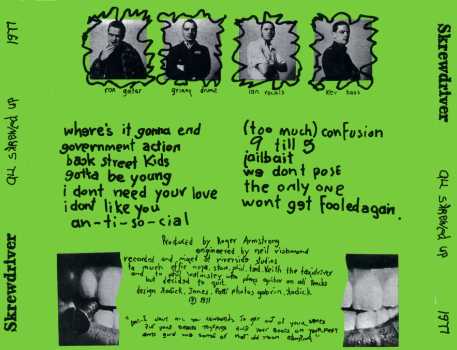
Issued as 45 RPM in 4 different sleeve colours of yellow, green, orange and pink. The yellow and green LP’s are labelled CH3 and the orange and pink have the label number WIK 3. All 4 colours have the number CH3 on the back cover and on the side cover. Issued in Germany with yellow sleeve on Chiswick/Metronome 0067.057 with two extra tracks of Streetfight and Unbeliever. Later reissued as The Early Years on 2 LP’s on Ian Records – Volume 1 has 10 tracks and Volume 2 has 8 tracks & The Early Years CD Rock-O-Rama – RCD 155 – 1991 with 18 tracks.
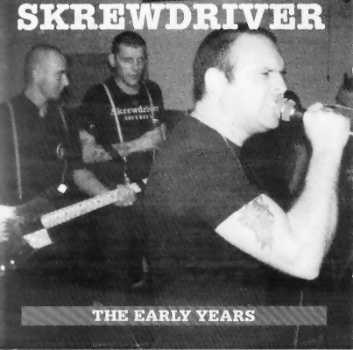
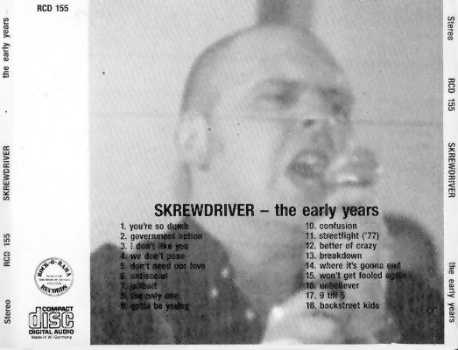
1979 – 7″ Build Up Knock Down/Case Of Pride/Breakout – (TJM-4 EP)1977 – 7″ Antisocial/Breakdown (Rolling Stones) – Chiswick label S-18 (8.10.1977)
1982 – 12″ Back With A Bang/I Don’t like You – (Boots & Braces – SKREW T 1)
1983 – 7″ White Power/Smash The I.R.A./Shove The Dove – (White Noise – WN1)
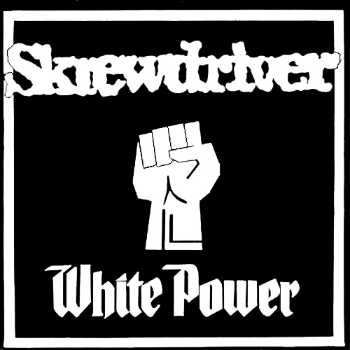

Ian Stuart – vocals, Frenchie – bass, Lester – guitar, Mark – drums, Joe Pearce – backing vocals.
1984 – 7″ Voice Of Britain/Sick Society – (White Noise – WN2)
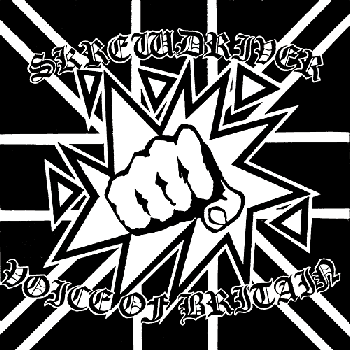
Ian Stuart – vocals, Frenchie – bass, Lester – guitar, Geoff – drums.
1984 – 7″ Invasion/On The Streets – (Rock-O-Rama – RRR 47)
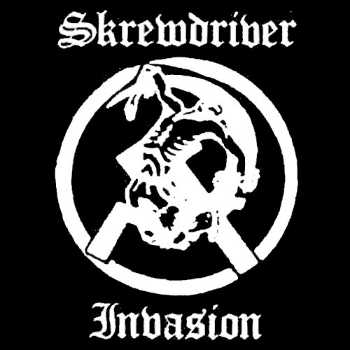

1984 – LP Hail The New Dawn – (Rock-O-Rama – RRR 46)
Was later re-released in a generic Street Rock`N`Roll sleeve, center label was still the RRR 47 label but with a small hole instead of the large hole the original version has.


Also reissued on CD 1990 with the bonus tracks of Tearing Down the Wall and Dont Let Them Pull You Down from the No Surrender Volume 1 compilation.Hail The New Dawn, Our Pride Is Our Loyalty, Before The Night Falls, Justice, Race & Nation, Flying The Flag, If There’s A Riot, Tomorrow Belongs To Me, Europe Awake, Soldier Of Freedom, Skrew You, Pennies From Heaven, Power From Profit, Free My Land.
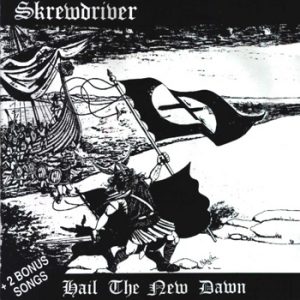
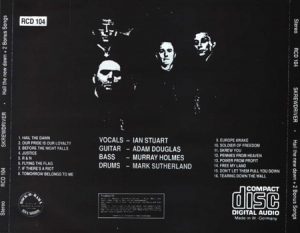
Ian Stuart – vocals, Adam Douglas – guitar, Murray Holmes – bass, Mark Sutherland – drums
Engineered and produced by Mark Sutherland. All songs by Ian Stuart except Justice by Nicky Crane & Ian Stuart, and Race & Nation by Matt Morgan and Ian Stuart. Vinyl centre labels may have no country listed on them, later ones have Made in W.Germany or Made in Belgium on them and also on the back of the sleeve.
The CD re-release of RRR 46 plus two songs from RRR 52 of 15. Dont Let Them Pull You Down and 16. Tearing Down The Wall.
Bootlegs exist. This CD is no longer in production by Rock-O-Rama due to the song “Race & Nation”. In 2005, ROR released the remaining songs from this CD on a series of 4 vinyl EPs. All the current editions being sold are probably bootlegs.
1985 – LP Blood & Honour – (Rock-O-Rama – RRR 53)

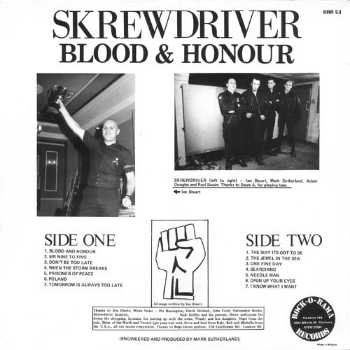
The CD re-release of RRR 53 plus two songs from RRR 59. CD reissue has the same tracks as the vinyl release with two bonus tracks of 15. Streetfight (1986) and16. Friday night.Blood & Honour, Mr. Nine To Five, Don’t Be Too Late, When The Storm Brakes, Prisoner Of Peace, Poland, Tomorrow Is Always Too Late, The Way It’s Got To Be, The Jewel In The Sea, One Fine Day, Searching, Needle Man, Open Up Your Eyes, I Know What I Want.
No longer in production, the legal songs have been released under another title. Any “new” CDs you see of this title are probably bootlegs.
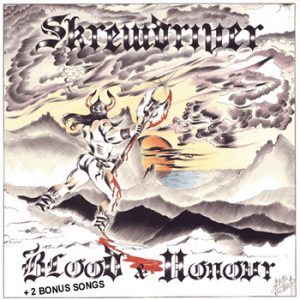
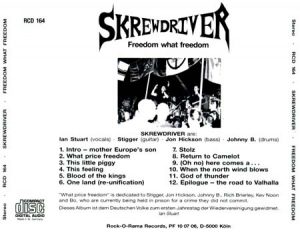
Ian Stuart – vocals, Mark Sutherland – drums, Adam Douglas and Paul Swain – guitar, Steve A – bass
1987 – 12″ / LP Boots & Braces – (Rock-O-Rama – RRR 67)

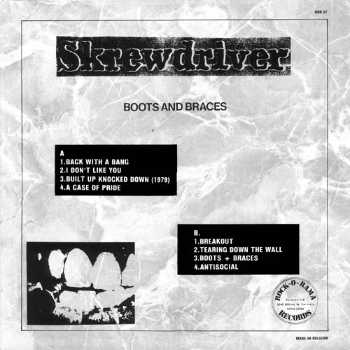
Tracks 1 and 2 are from the Back With a Bang 12″ (1982), tracks 3, 4 & 5 are from the Built Up Knocked Down 7″ (1979), track 6 from the first No Surrender compilation (RRR52 1985) and tracks 7 & 8 from the United Skins compilation (1982).Build Up Knock Down, Case Of Pride, Breakout, Back With A Bang, I Don’t like You, Tearing Down The Wall, Boots & Braces and Antisocial (new version from the United Skins compilation).
1987 – 12″/LP Voice Of Britain – (White Power Records – WP 3)
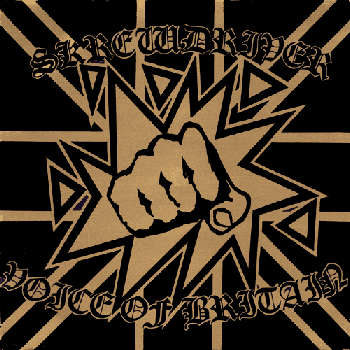
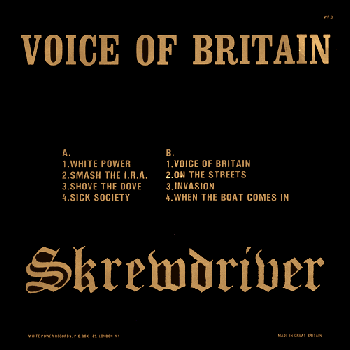
Tracks 1, 2, and 3 are from the White Power single (White Noise 1983), tracks 4 and 5 are from the Voice of Britain single (White Noise, 1983). 6 and 7 are from the Invasion single (RRR47, 1984) and track 8 is from This Is White Noise EP (White Noise 1984).White Power, Smash the I.R.A., Shove the Dove, Voice of Britain, Sick Society, Invasion, On the Streets, When the Boat Comes In.
Ian Stuart – vocals, Frenchie – bass, Murray Holmes, Geoff – drums, Mark Sutherland, Lester – guitar, Adam Douglas.
1987 – LP We’ve Got The Power (Live ’87) – (Viking Records VIK 1)
White Power, Streetfight, Europe Awake, Voice Of Britain, Built Up Knock Down, Strikeforce, Blood & Honour, I Don’t Like You, Our Pride Is Our Loyalty, Boots & Braces, Free My Land, Back With A Bang.

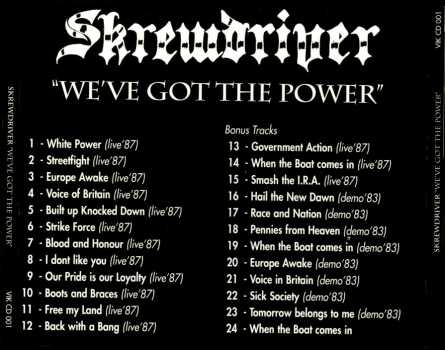
Reissued on CD with bonus live and demo tracks Government Action (live 87), When The Boat Comes In (live 87), Smash The I.R.A (live 87), Hail The New Dawn (demo 83), Race & Nation (demo 83), Pennies From Heaven (demo 83), When The Boat Comes In (demo 83), Europe Awake (demo 83), Voice Of Britain (demo 83), Sick Society (demo 83), Tomorrow Belongs To Me (demo 83), When The Boat Comes In (studio) – VIK CD 001
1987 – LP White Rider – (Rock-O-Rama – RRR 66)

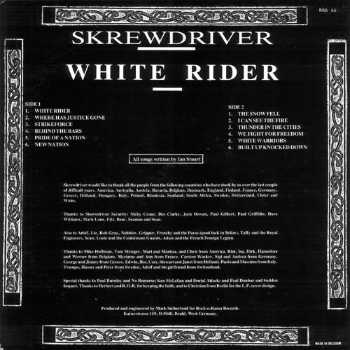
Ian Stuart wrote many of the songs while serving time in jail. Early copies came with single sheet insert, later replaced by printed sleeve.White Rider, Where Has Justice Gone, Strikeforce, Behind The Bars, Pride Of A Nation, New Nation, The Snow Fell, I Can See The Fire, Thunder In The Cities, We Fight For Freedom, White Warriors, Built Up Knock Down (1987).
CD re-release of RRR 66. Bootleg copies have RRR 66 on the back cover image from the LP where the official CD does not show this.
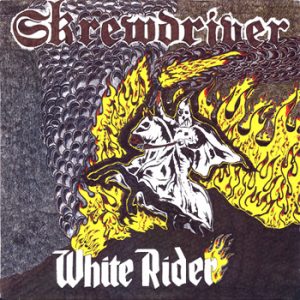
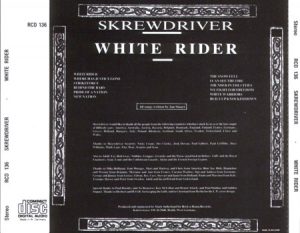
Ian Stuart – vocals, Merv Shields – Bass, Mark Sutherland – Drums, Guitar – Martin Cross
1988 – LP After The Fire – (Rock-O-Rama – RRR 75)
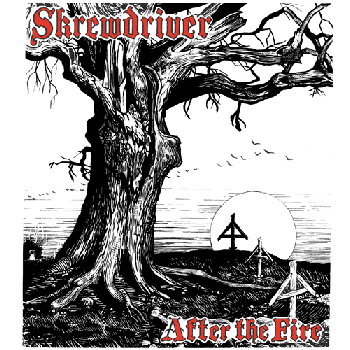
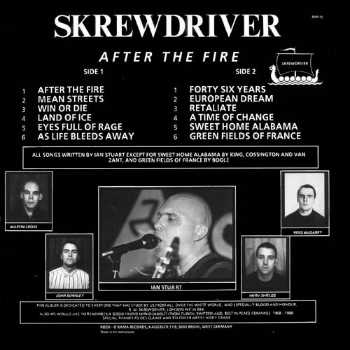
CD re-release of RRR 75 as Rock-O-Rama Records – RCD 137After The Fire, Mean Streets, Win Or Die, Land Of Ice, Eyes Full Of Rage, As Life Bleeds Away, Forty Six Years, European Dream, Retaliate, A Time Of Change, Sweet Home Alabama(Lynyrd Skynyrd), Green Fields Of France.
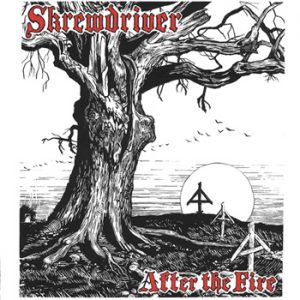
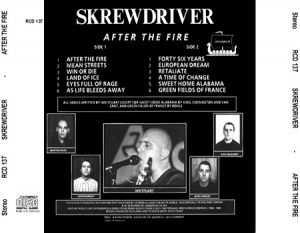
Ian Stuart – vocals, Martin Cross, Ross McGarry – guitars, Merv Shields – bass, John Burnley (Paul Burnley of No Remorse’s brother) – drums
1988 – 7″ After The Fire/Sweet Home Alabama (Lynyrd Skynyrd) – (Street Rock’N’Roll – SR01)
Both tracks from the After the Fire LP.
Ian Stuart – vocals, Martin Cross, Ross McGarry – guitars, Merv Shields – bass, John Burnley drums.
1989 – 7″ Land Of Ice/Retaliate – (Street Rock’N’Roll – SR-019)
Both songs from the After the Fire LP
1989 – 7″ Their Kingdom Will Fall/Simple Man(Lynyrd Skynyrd) – (Street Rock’N’Roll – SR-027).
Both songs from the Warlord LP
1989 – 7″ The Evil Crept In/Glory – (Street Rock’N’Roll – SR-028).
Both songs from the Warlord LP
1989 – 7″ The Showdown/Deep Inside – (White Pride Records – SRT 9KS)
1989 – LP Warlord – (Rock-O-Rama – RRR 85)


CD release of RRR 85. The first Skrewdriver album to be officially released on CD. The official ROR version of this CD is burned on a black disc with the white background label.Warlord, One In A Million II, Out In The Cold, Their Kingdom Will Fall, The Evil Crept In, Simple Man(Lynyrd Skynyrd), Soar Aloft, Back In Black(AC/DC), Glory, Excalibur, The Warrior Song, Suddenly.
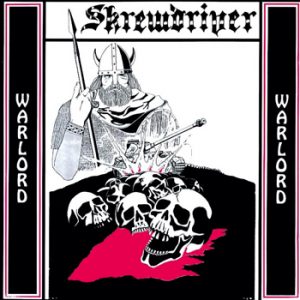

Vocals – Ian Stuart, Guitar – Mac, Bass – Merv Shields, Drums – John Burnley, Backing vocals – Ken McLellan, Paul Burnley, Melvis the Pelvis
1990 – LP The Strong Survive – (Rock-O-Rama – RRR 103)
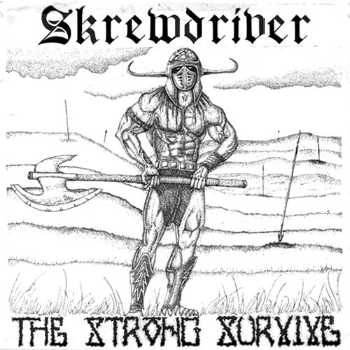
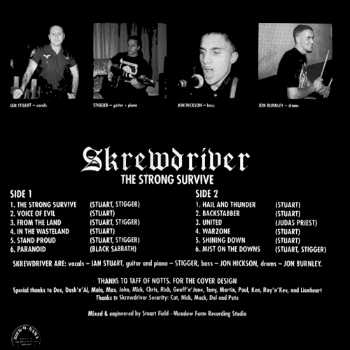
In the Wasteland is missing from the LP even though listed on the cover. But the CD reissue RCD 132 (1991) does have this track. Because of this error only about 1000 copies of the LP were pressed. RCD 132 CD – 1991 CD release of RRR 103.The Strong Survive, Voice Of Evil, From The Land, In The Wastland, Stand Proud, Paranoid (Black Sabbath), Hail & Thunder, Backstabber, United (Judas Priest), Warzone, Shining Down, Mist On The Downs.
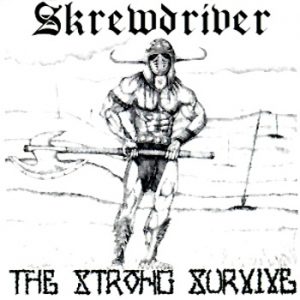
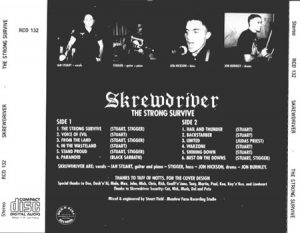
Ian Stuart – vocals, Stigger – guitar, Jon Hickson – bass, John Burnley – drums
1990 – 7″ You’re So Dumb/The Only One – (Street Rock’N’Roll – SR-038).
Both songs from the Early Years 1 LP
1990 – 7″ Streetfight (1977)/Where’s It Gonna End – (Street Rock’N’Roll – SR-039).
Both songs from the Early Years 2 LP
1990 – 7″ Stand Proud/Backstabber – (Street Rock’N’Roll – SR-052).
Both songs from the Strong Survive LP
1990 – 7″ Warzone/Shining Down – (Street Rock’N’Roll – SR-053).
Both songs from the Strong Survive LP
1990 – Boots and Braces / Voice of Britain – (Rock-O-Rama Records – RCD 106)
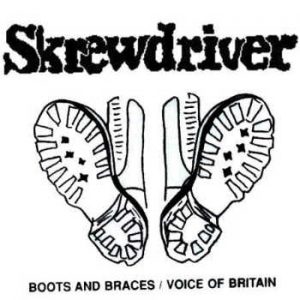
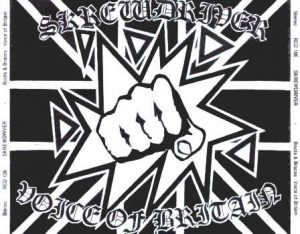
Back With a Bang, I Don’t Like You, Built Up Knocked Down, A Case of Pride, Breakout, Tearing Down the Wall, Boots and Braces, Antisocial, White Power, Smash the I.R.A., Shove the Dove, Sick Society, Voice of Britain, On the Streets, Invasion.
CD re-release of RRR 67 and WP 3. Bootlegs don’t show the marbled pattern in the background like the LP cover of Boots and Braces does. CD re-release of RRR 67 and WP 3 minus one song.
Bootlegs exist. The current official ROR version is burned on a black disc with a white background label. On the original ROR version, you can see a little bit of the marbled background that was on the LP cover. The current ROR version no longer has the Voice of Britain cover on the traycard, it now uses an altered version of the back of the original front-card with the track listing. Some bootlegs show the wrong year on the disc.
1990 – Early Years Volume 1 LP – (Ian Records – IAN 001)
You’re So Dumb, Government Action, I Don’t Like You, We Don’t Pose, Don’t Need Your, Love, Antisocial, Jailbait, The Only One, Gotta Be Young, Confusion.
Volume One of the ROR re-release of all of the 1977-1978 Skrewdriver material
1990 – Early Years Volume 2 LP – (Ian Records – IAN 002)


Volume Two of the ROR re-release of all of the 1977-1978 Skrewdriver material Streetfight (1977), Better Off Crazy, Breakdown, Where It’s Gonna End, Won’t Get Fooled Again, Unbeliever, 9 Till 5, Backstreet Kids.
1991 Also re-issued on CD as Skrewdriver – The Early Years – Rock-O-Rama Records RCD 155 CD re-release of IAN 001 and IAN 002
1991 – LP Live & Kicking (double live album) – (Rock-O-Rama – RRR 109)
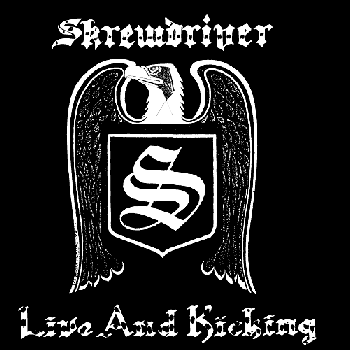

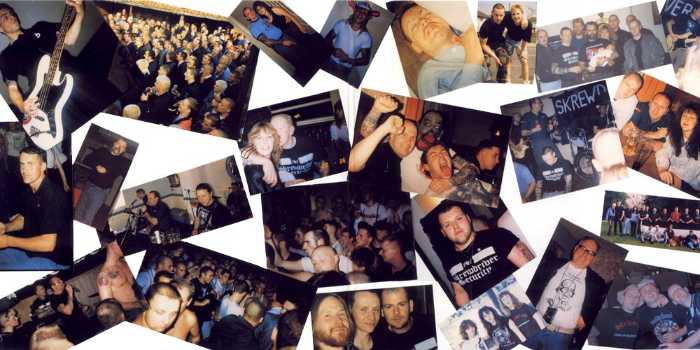
Hail The New Dawn, Strikeforce, Europe Awake, The Showdown, Stand Proud, Land Of Ice, Paranoid, Back With A Bang, Streetfight, Johnny Joined The Klan, The Snow Fell, 46 Years, Backstabber, Sweet Home Alabama, Tomorrow Belongs To Me, Glory, Red Flags Are Burning, Blood & Honour, Free My Land, Smash The I.R.A., White Power, Hail The New Dawn.
Reissued on CD in 1991 RCD 147
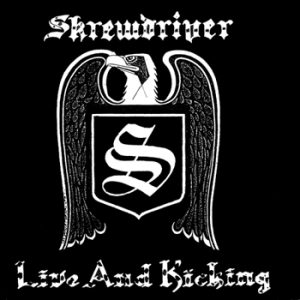
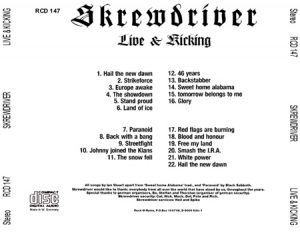
Stuart, Stigger, Hickson, and Burnley
1992 – LP Freedom What Freedom – (Rock-O-Rama – RRR 121)
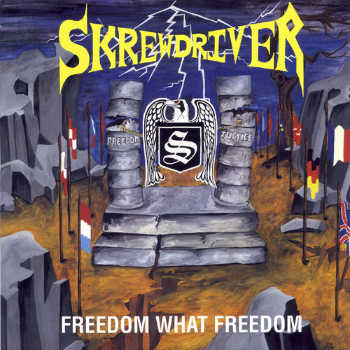
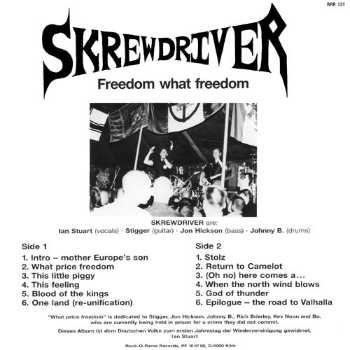
Ian Stuart – vocals, Stigger – guitar, Jon Hickson – bass, Johnny B – drums Intro-Mother Europe’s Son, What Price Freedom, This Little Piggy, This Feeling, Blood Of The Kings, One-Land, Stolz, Return To Camelot, (Oh No) Here Comes A Commie, When The North Wind Blows, God Of Thunder, Road To Valhalla.
On the record label the title track is What Price Freedom, this was released while most members of the band were being held in custody in Germany for a crime they did not commit. Reissued on CD as RCD 164
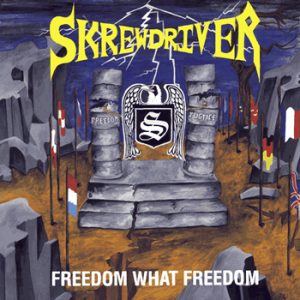

1994 – CD Hail Victory – (ISD Records – ISD 01)

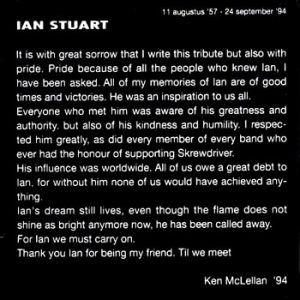
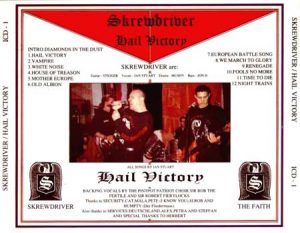
Intro & Hail victory, Vampire, White noise, House of treason, Mother Europe, Old Albion, European battle song, We march to glory, Renegade, Fools no more, Time to die, Night trains.
Guitar – Stigger, Vocals – Ian Stuart, Drums – Mushy, Bass – Jon H
Backing vocals by the Pintpot Patriot Choir, Sir Rob the Fertile and Sir Robert Fireylocks.
The last album of original Skrewdriver material, as Ian Stuart died in an automobile accident the previous year. This album has seen several different forms, the first was this particular issue, which was released by Rock-O-Rama under the ICD catalog numbering. This edition does not give an imprint name, but the LP version of one of the following releases on this imprint (ICD-03) says “ISD Records” on the center labels. However, there is another label called ISD Records, which is run by C18/Blood & Honour/ISD, and it also released this CD. The album cover is a different painting of the same scene. The main difference on the back cover is that the ROR version thanks Herbert, while the C18/B&H/ISD version isn’t quite as kind to Herbert.
This One’s For The Skinheads (Live 23 April 1987 Halesworth) – (MSR Productions – MSR CD 236)
White Power, Hail The New Dawn, Government Action, Europe Awake, Streetfight, Built Up Knock Down, Boots & Braces, Back With A Bang, Blood & Honour, Strikeforce, Our Pride Is Our Loyalty, Voice Of Britain,, When The Boat Comes In, Smash The I.R.A., Tomorrow Belongs To Me, Free My Land, I Don’t Like You, White Power.
1998 – Last Gig in Germany (10th July 1993) – Bootleg CD
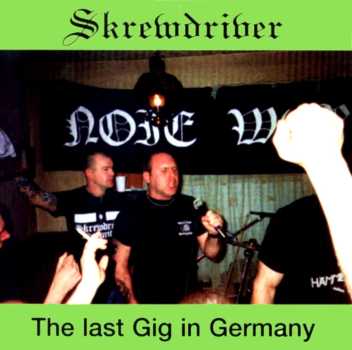
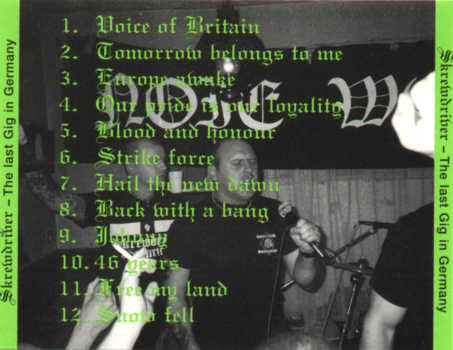
Voice of Britain, Tomorrow Belongs to Me, Europe Awake, Our Pride is Our Loyalty, Blood and Honour, Strike Force, Hail the New Dawn, Back with a Bang, Johnny, 46 Years, Free My Land, Snow Fell.